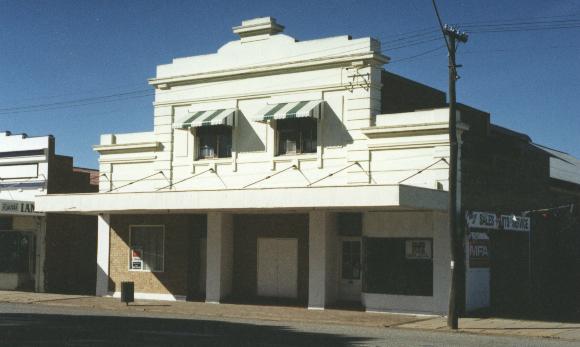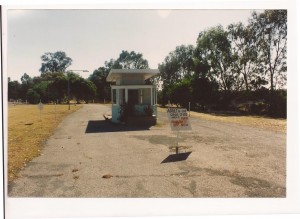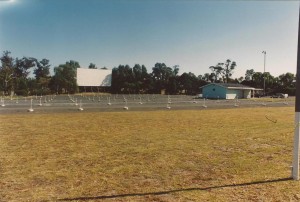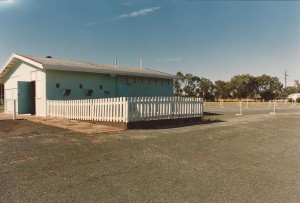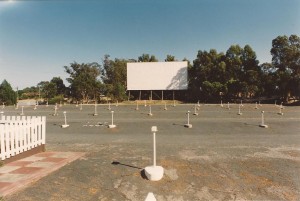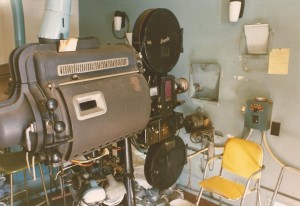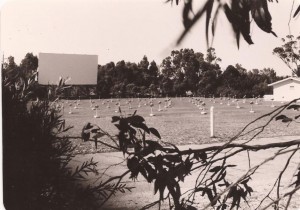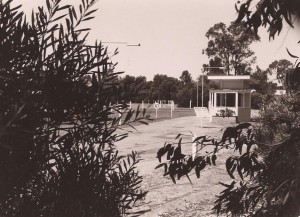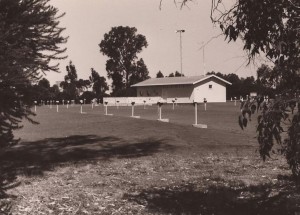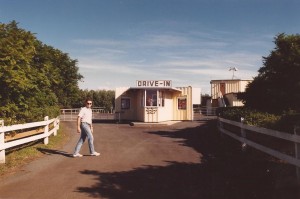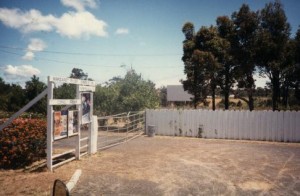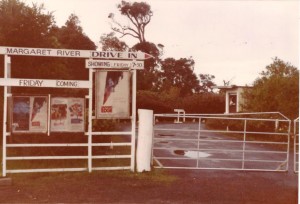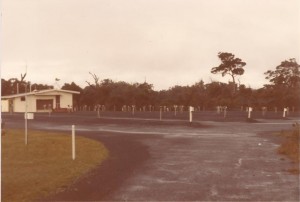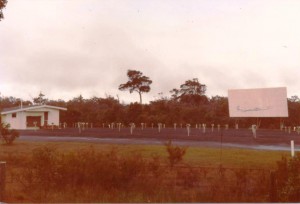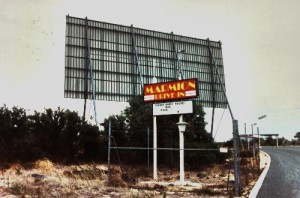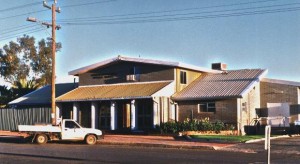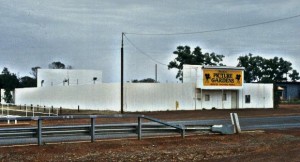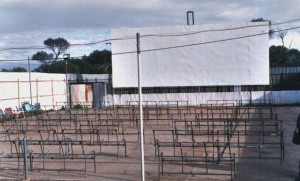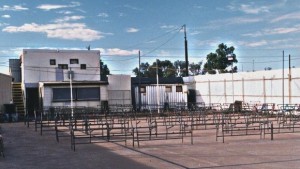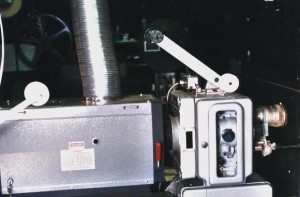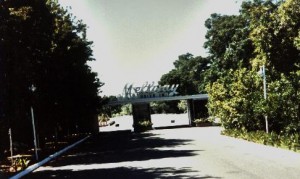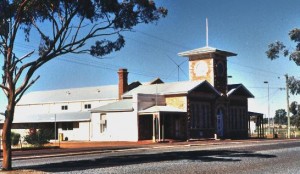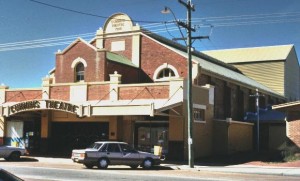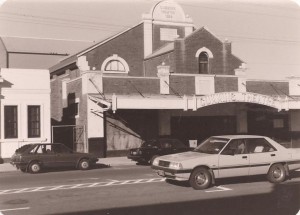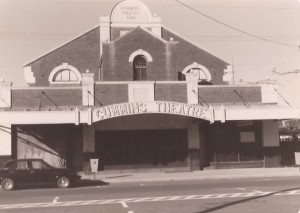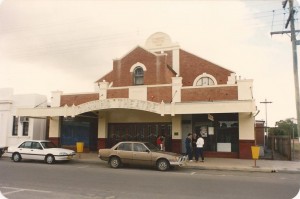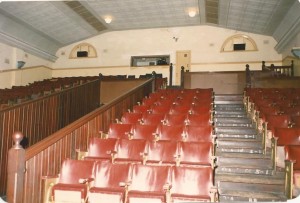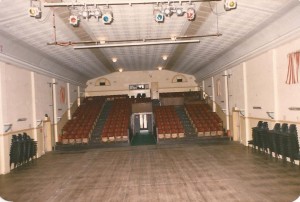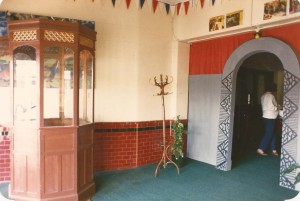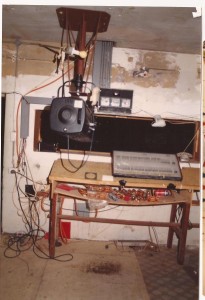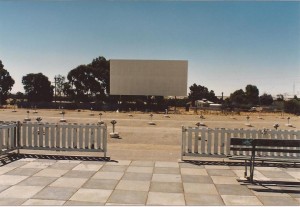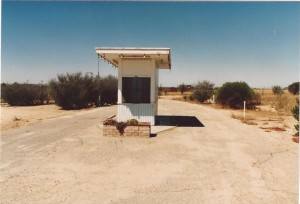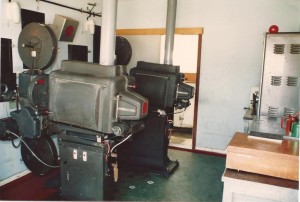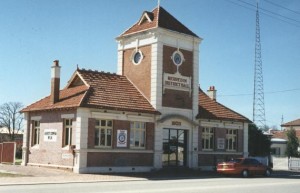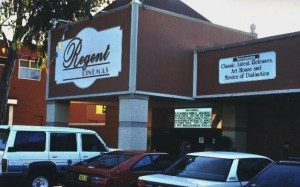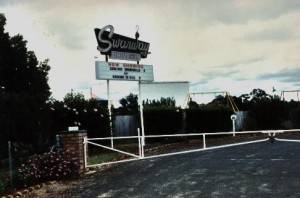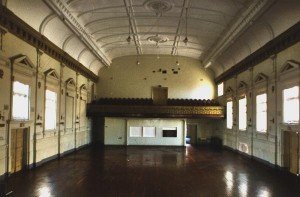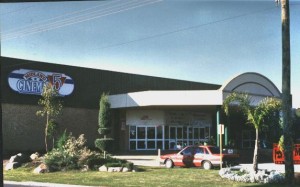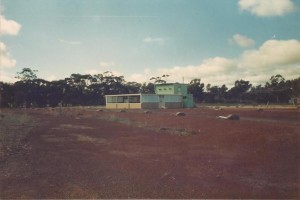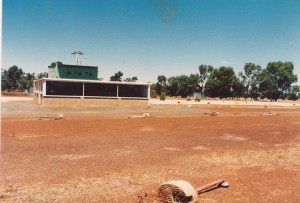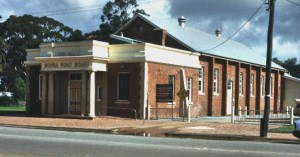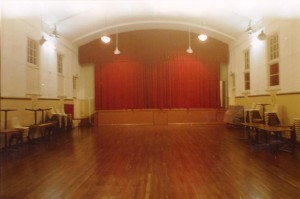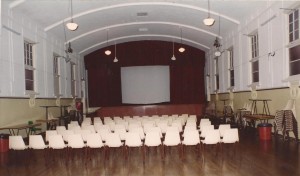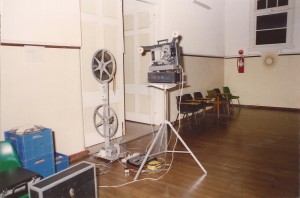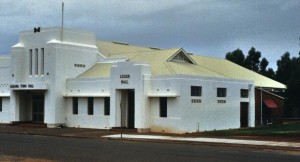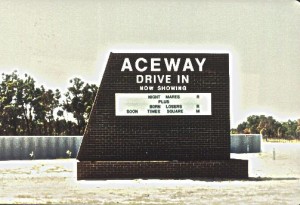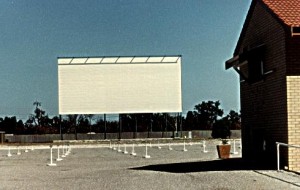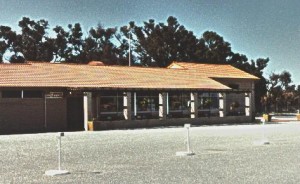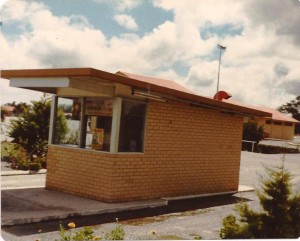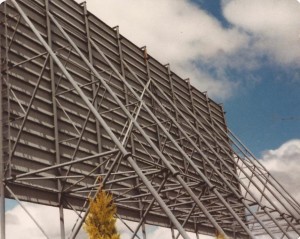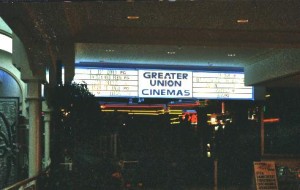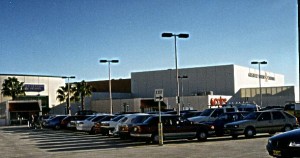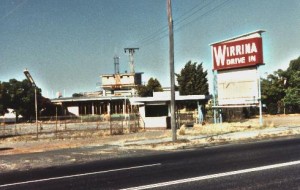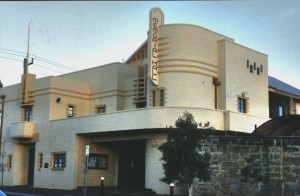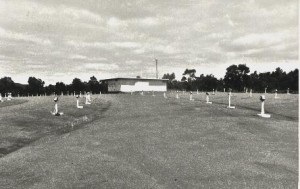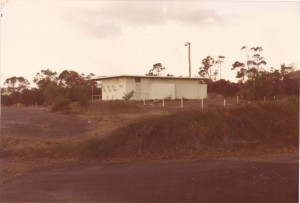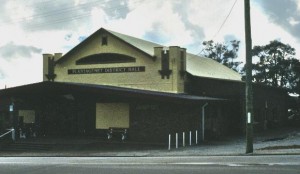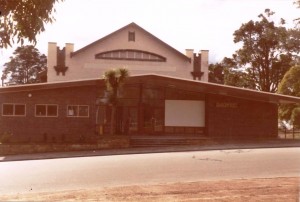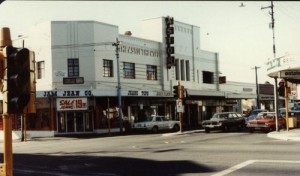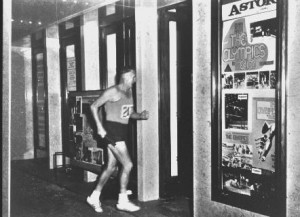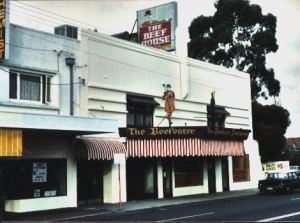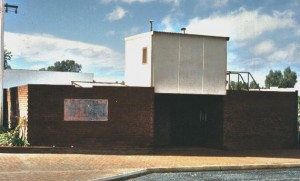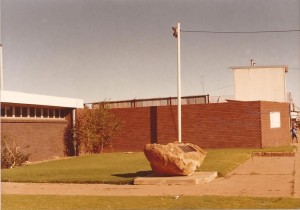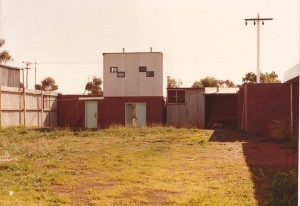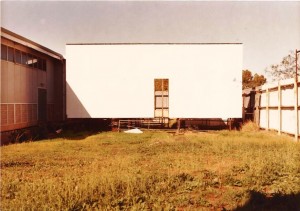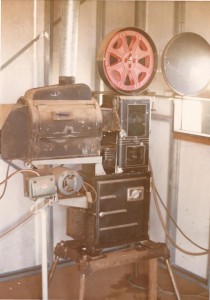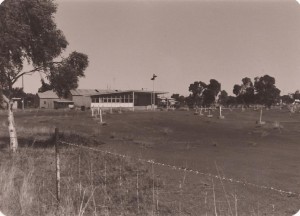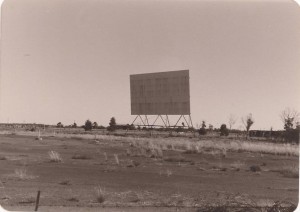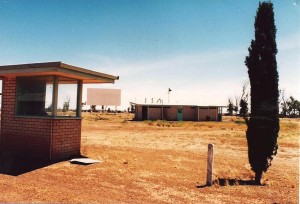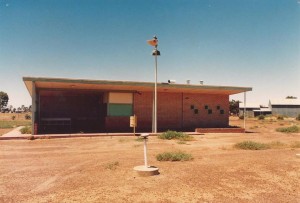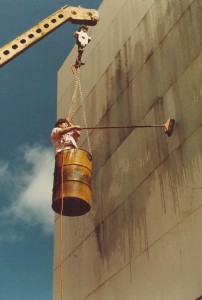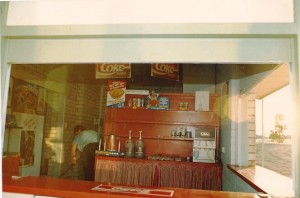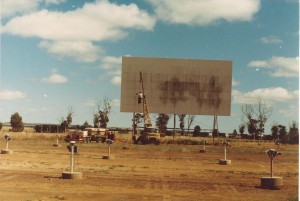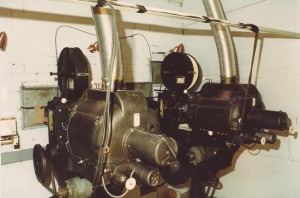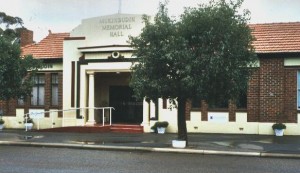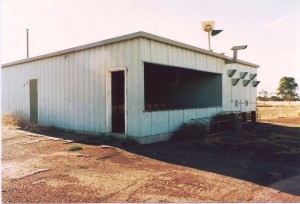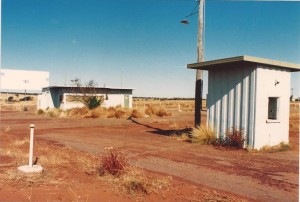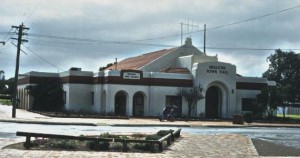Quicklinks
MADDINGTON
CENTENARY HALL, Maddington
Early film screenings took place in the Roads Board Hall. Maddington Centenary Hall was opened 18 January 1930: ´The hall is a splendid building and is a monument to those responsible for its erection. Men may come and men may go but the hall will be there for ever.’ (Swan Leader 17 January 1930) In March 1930, screenings began regularly on Thursday nights, but these ceased early the following year when Mr Stout the proprietor could not pay the rent on the hall, which may have been one local manifestation of the world-wide depression. By 1934, the Hart brothers were providing the weekly Thursday night screening, then from at least 1940 to about 1952 it was Bart Mott’s Star Entertainments, followed from 1953 to about 1958 by A.E.Randell, then by F.Waldron to about 1961. Despite that earlier press claim of immortality, the hall was demolished in 1983 to make way for McDonalds.
Sources: Film Weekly Directory 1940/41 – 1960/61
Swan Leader 17 January 1930; 24 January 1930; 14 March 1930, 28 March 1930; 20 March 1930; 28 September 1934
Photos: Swan Leader 24 January 1930
TWILIGHT DRIVE-IN THEATRE, Dellar Rd, Maddington
This was built in 1972 by an independent exhibitor, T.M.Rainch. In the late seventies and early eighties it survived by specialising in R-movies, and it is not clear when it closed. By 1997 the land had been cleared, and part of it had been used for a housing estate.
Sources: Public Health Department, building permit, Battye 1459
West Australian, 12 August 1970, 23 September 1970, 1972 – 1985
MANDURAH
AGRICULTURAL HALL, Pinjarra Rd, Mandurah
The Agricultural Hall was built on the south side of Pinjarra Rd, east of the bridge. This was a stone building with a brick facade and a corrugated iron roof, substantially altered over the years. It was used for film screenings in the very early years, before the Hotham Valley Hall was used for this purpose. It still stands, in use by the Council (in 1997 as the Rangers Office).
Sources: Peel Region, Heritage Inventory, p.105
AMBASSADORS THEATRE AND GARDENS, Mandurah Terrace, Mandurah
The Ambassadors Theatre and Gardens was built in Mandurah Tce, on the north side of the intersection with Smart St. It was run by the Tuckey family, or leased to others, and both the theatre and gardens did well, screening up to 6 nights per week in the summer months. The gardens seated 300, on about a quarter acre block of deckchairs on grass. The theatre closed in about 1962, and the gardens continued for a further three or four years, closing in the late sixties.
Sources: Film Weekly Directory 1940/41 – 1966/7
Max Bell, Perth, a cinema history, The Book Guild Ltd, Lewes, Sussex 1986, pp.99-100
Interviews (Ina Bertrand): Alan Larkin (1985), N.J.Woods (1985)
Interview (Colleen Pead): Owen Tuckey (1986)
Informant: Linda Bowron (1997)
BOARDWALK 6, Ormsby Rd, Mandurah
In 1987 it was announced that a small twin cinema would be built in Mandurah, but nothing came of that proposal. Some years later a $23 million performing arts centre was built in Ormsby Rd, in a spectacular location overlooking the water. It contained an 800 seat theatre with flytowers for live performance.
In 1997 a new six-cinema complex was built for Readings Cinemas, next door to – and facing – the Performing Arts Centre, but not quite as spectacular in location.
Sources: Max Bell, Kino, no.22, December 1987: p.23 no.52, June 1995, p.30; no.59, March 1997, p.31; no.63, Autumn 1998, p.35
West Australian 1999-2000
HOTHAM VALLEY HALL, 9 Pinjarra Rd, Mandurah
The first permanent film show in Mandurah was conducted by Mrs Lanyon in the Hotham Valley Hall, on the south side of Pinjarra Rd, east of the Agricultural Hall. This was a small red brick and stone hall, built in 1898. It had a good dance floor, so was used for dancing and other social occasions as well as for pictures.
In 1928, Mrs Lanyon moved on to the Capitol and sold the Hotham Valley hall to the Tuckey family, who renovated the building and placed the date (1928) prominent on the facade. The first sound films in Mandurah were screened here and the Tuckey family continued to screen here until the fifties. The Hotham Valley Hall has since been demolished.
Sources: Ronald Richards, Murray and Mandurah: a sequel history of the old Murray district of Western Australia , Shire of Murray and City of Mandurah, 1993, p.493
Informants: Linda Bowron & Beryl Slade (Mandurah, September 1997)
Photos: 1 exterior, b&w, approx.1930, Ronald Richards, Murray and Mandurah: a sequel history of the old Murray district of Western Australia, Shire of Murray and City of Mandurah, 1993, p.493
MANDURAH DRIVE-IN, Dower St, Mandurah
Local exhibitor Owen Tuckey, and Alan Larkin of Harvey and Bridgetown were shareholders with others in Mandurah Drive-in Pty Ltd, the company formed to build the drive-in. It opened in Dower St on the north-east corner of Pinjarra Rd in September 1960, with provision for 344 cars.
In January 1981, Colin Langley became manager, and was there when the venue closed in August 1989. In 1990 it was put up for sale, was reopened in 1993 by Coastal Drive-ins and closed again in June 1994, shortly after the biobox was gutted by fire. The carpark of the Forum Shopping Centre is now on the site.
Sources: Film Weekly Directory 1960/61 – 1971
Max Bell, Perth, a cinema history, The Book Guild Ltd, Lewes, Sussex 1986, p.137
Kino, no.29, September 1989, p.23; no.31, March 1990, p.23; no.43, March 1993, p.31; no.49, September 1994, p.31
West Australian 1961 – 1962
Interviews (Ina Bertrand): Colin Langley (1997), Alan Larkin (1985)
Interview (Colleen Pead): Owen Tuckey (1986)
Photos: 4 exterior, colour, 1988, Roy Mudge
1 interior of bio box 1989 colour, Roy Mudge
3 exterior, sepia, 1980’s, Max Bell
MEMORIAL THEATRE/ CAPITOL HALL & GARDENS, cnr Sutton & Pinjarra Rds, Mandurah
Soon after selling the Hotham Valley Hall in 1928, Mrs Lanyon built a new hall and began screening in competition with the Hotham Valley Hall till the outbreak of war. The Capitol was located on the north side of Pinjarra Rd: from the Anglican Church on the corner of Sholl St to Sutton Rd there was a picture gardens, a house and a hall, all owned by Mrs Lanyon. The hall opened in 1928 and was used for many community purposes, including film screenings, for many years: in 1931, she built a gardens next door. Mrs Lanyon conducted a touring picture show, which included the Capitol and gardens in its circuit, then the screenings were run by Mr Waters.
At the end of the thirties, this venue was operated in the summer months as part of Bart Mott’s Star Entertainments circuit. For one summer, Charles Legg, who had injured his arm and was unable to go on the circuit as usual, screened there on his own behalf: he did not do very well, except with Dad and Dave, which he screened on a wet Saturday night.
The building was demolished and now a small shopping centre runs through the site from Pinjarra Rd to Church Rd.
Sources: Post Office Directory 1935/6-1949
Ronald Richards, Murray and Mandurah: a sequel history of the old Murray district of Western Australia, Shire of Murray and City of Mandurah, 1993, p.494-5
Interview (Colleen Pead): Owen Tuckey (1986)
Photos: 1 exterior, b&w, approx.1938, Ronald Richards, Murray and Mandurah: a sequel history of the old Murray district of Western Australia, Shire of Murray and City of Mandurah, 1993, p.494
OPEN AIR PICTURES, Mandurah Terrace, Mandurah
Mrs Nel Blakeley (nee Lanyon) provided local historian Ronald Richards with a photo of an open air picture gardens, dated about 1925, which she described as ´built on land next to the Brighton Hotel’. The photo clearly shows that the gardens is next to a two-storey building, though there is not enough detail to clearly identify the hotel. Ronald Richards describes how mosquitoes were controlled in this venue by smouldering cow dung. It seems that this gardens was located where the hotel beer garden is located in 1997, and possibly was run in conjunction with the Hotham Valley Hall, which means it probably closed in 1928 when the Tuckeys purchased the hall.
Sources: Ronald Richards, Murray and Mandurah: a sequel history of the old Murray district of Western Australia , Shire of Murray and City of Mandurah, 1993, p.493-4
Photo: Ronald Richards, Murray and Mandurah: a sequel history of the old Murray district of Western Australia , Shire of Murray and City of Mandurah, 1993, p.493
MANIANA
MANIANA HALL, Maniana
Screenings were being offered at the Maniana Hall over the summer of 1959-60, and possibly longer than this. Plans for a gardens adjacent to the hall were approved, but there is no record that this was ever opened.
Sources: Film Weekly, 7 January 1960, p.3
West Australian, 1959 – 1960
MANJIMUP
MANJIMUP DRIVE-IN, Pritchard St, Manjimup
Allan Jones built the Manjimup Drive-in on the southern side of Pritchard St, opposite the junction of Rose St. It opened in 1961 with provision for 200 cars, and was very successful. After Allan Jones’ death in 1982, the family company Jones Cinewest Drive-ins, continued to operate this venue along with others, but it was open only intermittently by the time the site was sold in 1993. The land was subdivided for an industrial estate.
Sources: Film Weekly Directory 1961/2 – 1971
Max Bell, Perth, a cinema history, The Book Guild Ltd, Lewes, Sussex 1986, pp.136-7
Kino, no.19, March 1987, p.10; no.52, June 1995, p.30
Informants: Ron Jones (Busselton, September 1997), Margaret McIllhatten (Manjimup, September 1997)
Photo, 1 exterior, colour, 1988, Roy Mudge
ROBBIES HALL, Ipsen St, Manjimup
Robert (Robbie) Robinson was born in 1862 and arrived in Australia in 1908. He came to Manjimup with his family in 1910 and soon after built ´Robbie’s Corner’, a cafe on the north-west corner of the intersection of Giblett and Ipsen Streets. Behind the cafe, and separated from it by a narrow entrance lane, he built Robbies Hall, which extended along Ipsen St to another, more substantial, laneway. This was a timber hall, with a timber floor and corrugated iron roof, and entrance was in the lane at the back of the cafe. It had a built-in bio-box and rows of unpadded, fold-up wooden seats. Robinson screened the first regular silent films in the district in this hall, on Friday and Saturday nights each week. As he also owned the cafe next door, this would have been the place to buy refreshments at interval (unless he also had attendants in the theatre who sold from trays).
In the twenties, Mr Chinnery screened in Robbies Hall, (which may have been then owned by Davis and Davis, who owned the draper’s shop next door), in competition with Allan Jones at the Town Hall. In the fifties, Jones screened for several years in both the Town Hall and Robbies Hall, before building the Roxy.
Sources: Film Weekly Directory 1952/3 – 1957/8
Manjimup-Warren Times 29 August 1956
Informant: Mrs D. Jones (Busselton 1985), Margaret McIllhatton (Manjimup, September 1997)
ROXY, Rose St, Manjimup
Allan Jones built the Roxy Theatre, in Rose St, near the north-east corner of the intersection of Rose and Brockman Streets. It was designed by R.M.Neal and Associates of Perth, seated three hundred, and was opened on 24 August 1956:
Terrazzo steps lead to the theatre foyer off Rose-street. The floor is tiled with a pleasing red and buff design by Foys of Manjimup. In the right-hand corner is a small confectionery stall, with a slat-front and shelving which matches the ticket counter opposite. The screen across the main entrance is of the same design. Conveniences for both sexes and a baby pram park, lead off from the foyer, which is decorated in delightful tonings of coral rose, camellia and pottery blue..
The sloping floor has a fall of two feet from back to front…
There are side aisles and fixed blonde-wood seating, with arm rests, bucket backs and Dunlopillo upholstery which highlight the comfortable seats made by Peaker Bros. of Busselton…
Two special high fidelity speakers have been positioned into a recess in the rear wall and they are ample for the theatre which has overall measurements of 95ft. x 40ft.
The proscenium is tinted camellia, while the walls are coloured mushroom and lime yellow and the ceiling in tango. Racophone(sic) projectors are installed in a fire-proof bio-box and a Cinemascope plastic screen measures 29ft x 14ft. The large drape curtains are electrically operated.
The “Roxy” is well ventilated with rows of louvres along each wall, fitted with three feet long aluminium blades. Concealed updraught ventilation runs the full length of the ceiling and where too, special illumination has been installed. (Manjimup-Warren Times, 29 August 1956)
This theatre was the site of Jones’ only fire emergency: an inexperienced operator was about to throw blazing film out of the bio-box onto other films stacked in the corridor, when Jones intervened and smothered the blaze, probably saving the whole theatre. It closed in July 1972, and was sold to Woolworths, who used the site for a shopping complex.
Sources: Film Weekly Directory 1958/9 – 1966/7
Max Bell, Perth, a cinema history, The Book Guild Ltd, Lews, Sussex 1986, pp.97-8, 121
Allan Jones, Reminiscences of a Travelling Picture Showman , Busselton 1974, pp.8,9
Mrs D. Jones to Colleen Pead (1985)
Blackwood-Warren Sentinel 30 August 1956
Countryman, 30 August 1956
Manjimup-Warren Times 29 August 1956
TOWN HALL, Rose St, Manjimup
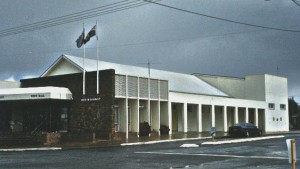
The Manjimup Town Hall was opened in June 1927, on the south-west corner of the intersection of Rose and Brockman Sts.
It is not clear whether silent films were screened here, and if so by whom. But Allan Jones was certainly screening here by the early thirties, and after installing sound at Pemberton, he installed X-L Tone at the Manjimup Town Hall, which became the headquarters for Jones’ circuits, eventually acting as the host for two of his four travelling vans. The first sound film to be shown in the town was Diggers, screened in June 1932. The hall screened three nights per week in the thirties, and four in the forties, before Jones built the Roxy and ceased screening at the Town Hall.
In the nineties, occasional screenings resumed, conducted by the Manjimup Arts Council.
Sources: Film Weekly Directory 1940/41 – 1957/8
Allan Jones, Reminiscences of a Travelling Picture Showman , Busselton 1974, pp.8,9
Informant: Margaret McIllhatton (1997)
Photos: 1 exterior, b&w, n.d.(1933?), 21st Anniversary Manjimup Week Celebrations Souvenir Booklet, 1933, p.18
1 exterior, colour, 1997, Graeme Bertrand
MANNING
WELWYN/MANNING GARDENS, Welwyn Ave, Manning
This was a simple open air cinema, with an imposing brick facade on the street frontage. It opened, opposite the shopping centre in Welwyn Ave, on 23 November 1956 and closed in 1963. It was operated by the Judge family.
Sources: Max Bell, Perth – a cinema history, The Book Guild, Lewes, Sussex, p.59
Jack Honnibal, “The cinemas of South Perth”, typescript, held in South Perth Heritage House
West Australian, 1956 – 1963
Photo: 1 exterior, b&w, West Australian, 21 November 1956
MARBLE BAR
PIONEER AND GARDENS/ AMBASSADORS GARDENS/ MODERN GARDENS/OPEN AIR PICTURE CINEMA, Marble Bar
Gold was discovered at Marble Bar in 1891, and the town grew fast, building a Miner’s Institute in 1898. There was no evidence of films in this building, which was badly damaged in a storm in 1914, and finally demolished in 1918. A new hall was not built until 1925, and was completely paid for by 1930, but again films were not regularly screened there.
This is not as surprising as it seems. Marble Bar has a reputation for being the hottest town in Australia, with a record of 106 consecutive days of temperature higher than 37.8 degrees. Watching movies in a hall, even with windows and doors open, was not comfortable in the days before air conditioning. Even outdoor entertainment, such as offered in an open air picture gardens, was difficult to sustain in the town.
Nevertheless, open air screenings seem to have been offered at least from 1940. One open air cinema was located (at the Comet Mine?) over a mile from town, and operated from 1941-44 by E.J.Jeffreys / E.N.Woods.
Within the town itself, from 1943 to 1951 an enclosure was in use behind the house belonging to A.J. (Sandy) Thompson, who also ran the garage. This enclosure had timber side walls, and a bio-box standing between the Thompson’s yard and the cinema seating, which was in rows of canvas-covered deckchairs. During the war, the cinema, which could hold about 150, was often full, attendance boosted by the men from the RAAF base.
From 1951 S.H.Stubbs operated a new open air venue in the area bounded by Bohemia St, General St, Nicholls St and the Shire Yard. A permit for alterations was granted in 1966, and these screenings continued till about 1973, when Stubbs withdrew. The venue was taken over by Alf Potter, who looked after the booking and projecting while his wife looked after the food. They bought their own (second hand)16mm projectors, but found the cost of films prohibitive, particularly transport costs. If the films came by road, the exhibitor had to pay for a week’s hire even though screening only once: if the films came by air, freight costs were more expensive, but hire was only for one night because the film could be returned next day. So, when the Health Department became insistent about renovating the toilets, the Potters closed the venue, in the early 1970s.
Soon after, Hawkstone Minerals wanted a show for their workers. They agreed to pay film hire and freight, if Potter screened for them, takings to be shared between Potter and the Hawkstone Social Club. Brian Shelton and Alf Potter did it on this basis for about one year, then Hawkstone moved out, so film screenings in the town closed again.
The next screenings in the town were at the school, around 1982-3. These weekly programmes were provided mainly for the school children, using one 16mm. projector, with breaks for reel changes. Bob Kelly was projectionist for about one year then Alf Potter for another year.
This stop-start history of movies in the town finally finished absolutely when TV arrived, in the mid-80s.
Sources: Kathleen Mallett, To the bar bonded: a history of early Marble Bar , East Pilbara Shire & Hesperian Press, 1993
Film Weekly Directory 1940/41 – 1971
Post Office Directory 1941/2-1944
Public Health Department, building permit, Battye 1459
Informants: Len Lever (Marble Bar 1999), Alf Potter (Marble Bar 1999)
Photo: 1 exterior (picture gardens), 1944, b&w, Kathleen Mallett, To the bar bonded: a history of early Marble Bar, East Pilbara Shire & Hesperian Press, 1993, p.309
MARGARET RIVER
HALL, Wilmott Ave, Margaret River
The first public hall in Margaret River was built in 1912 and extended in 1923. It was here that Owen Terry and Bert McLean ran silent pictures in 1929/30: McLean said “We used to have the bio-box up the back of the old hall and used to have to go up steps to it. Films came down on the train from Perth and we ran the projectors from a little lighting plant” (quoted in Cresswell, pp.229-230). Terry and McLean sold their business to a Mr Barnes, who sold in turn, less than a year later, to West’s circuit, which probably introduced talkies to the town.
In 1936 a new hall was built in Willmott Ave, and the old hall was relocated in Gloucester Park and used by local organisations. The first electricity in the town was provided by a private contractor from 1937, which made life easier for cinema showmen like Allan Jones from Busselton, who began showing pictures once a week in the new hall from 23 November 1938.
That hall was demolished to make way for the present Shire Hall in Townview Terrace, beside the Shire Offices, opened in 1955, and Jones’ screenings probably transferred to the new hall until the drive-in opened in 1965.
Sources: Film Weekly Directory 1940/41 – 1964/5
Gail J. Cresswell, The light of Leeuwin: the Augusta-Margaret River Shire History , Augusta-Margaret River Shire History Group, 1989
Interview (Ina Bertrand & Irma Whitford): Allan Jones (1978)
MARGARET RIVER DRIVE-IN, Bovell Ave, Margaret River
Allan Jones built a drive-in for 150 cars on the south side of Bovell Ave, just off the Bussell Highway. It opened in 1965, and after Jones’ death in 1982, it was one of those venues taken over by the family company – Jones’ Cinewest Drive-ins. In 1997 it opened over the summer months and in school holidays, like the Busselton Drive-in: first release product was shown first for a week in Cinema 1 in Busselton, then for a second week at the Busselton Drive-in, then for the third week in Margaret River. The company planned to introduce FM stereo sound in time for the 1997-8 summer season.
Sources: Film Weekly Directory 1965/6 – 1971
Public Health Department, building permit, Battye 1459
Max Bell, Perth, a cinema history, The Book Guild Ltd, Lewes, Sussex 1986, p.137
Kino, no.19, p.10
Interview (Ina Bertrand & Irma Whitford): Allan Jones (1978)
Informant: Ron Jones (Busselton, September 1997)
Photos: 1 exterior (entrance), 1985, Robert Newton
1 exterior (ramps and screen), 1985, Robert Newton
3 exterior , colour, 1980’s , Max Bell
MARMION (SORRENTO)
MARMION DRIVE-IN THEATRE, Marmion Ave, Marmion (Sorrento)
Northland Developments (in which Alan Chester and Graham Norton were involved) built the Marmion and Odin Drive-in Theatres, and ran them till they were purchased by the City Theatres/TVW group. The Marmion drive-in, which held 600 cars, was opened on the south-west corner of the intersection of Harmon Rd and Marmion Ave, on 30 January 1975, and closed in 1984. By 1997, the land had been used for a housing estate.
Sources: Public Health Department, building permit, Battye 1459
West Australian, 1975 – 1984
Interview (Ina Bertrand & Bill Turner): Graham Norton (1981)
Interview (Ina Bertrand): Arthur Stiles (1985)
Interview (Bill Turner): Alan Chester (1981)
Photos: 1 exterior, colour, 1981 (Bill Turner)
MARVEL LOCH
HALL, Marvel Loch
Film Weekly Directory lists T.H.Enright as the exhibitor here in 1940/41, then Rupert Morris’ circuit operated here from the late forties to the early fifties.
Sources: Film Weekly Directory 1940/41, 1948/9 – 1953/4
MAYLANDS
LYRIC THEATRE AND ROXY GARDENS, 47 Eighth Ave/ 240 Guildford Rd, Maylands
A Picture Gardens was advertising in Eighth Ave, Maylands in February 1920, but it is not clear if that is the same venue as the Lyric, which opened as a semi-open-air theatre at 47 Eighth Ave, in 1924, with a capacity of 600 patrons, operated by Thomas Snooks. In 1928 a hardtop theatre accommodating 1000 was built by Thomas Coombe (probably on this site). It was a beautiful building, with an impressive staircase and red carpet. Members of Maylands Historical Society recall that it was not possible to book seats at the theatre, but that certain people always sat in the same seat: if anyone else tried to sit there, there would be a great fuss!
In 1933, the Roxy Gardens opened at 240 Guildford Rd with seating for 900, built by H.R. Robinson (who later became Perth Shire Council president) and his sister Miss M.I. Robinson. The cheaper seats in this venue were wooden benches on bitumen, the dearer seats were deckchairs on grass. The screen was located at the rear of the site, and poplar trees were planted along the side wall. In the days of pan toilets, it was possible for the adventurous boys of the district to open the back of the men’s toilet, push the pan aside and crawl in through the hole, replace the pan and so gain free entry to the pictures.
The Lyric Theatre and Roxy Gardens were owned and operated by separate managements till 1934, when the Robinsons took over the operation of the theatre as well as the gardens, which they still owned outright. After that, despite the distance between them they were operated as a single enterprise, with screenings in one or the other depending on the weather. This continued until the Lyric closed in June 1961, and its fittings were dispersed at auction. The Lyric building became first an electrical goods showroom, then a growers’ market, and in 1997 was a Red Shield Op-shop. The upstairs pool parlour was leased out as a flat in recent years. The Roxy closed a year later than the Lyric, in June 1962: the site became a used-car yard, and in 1997 was a Coles supermarket.
Sources: Max Bell, Perth – a cinema history, The Book Guild, Lewes, Sussex, 1986, pp.31, 59, 66
Max Bell, ´Maylands (WA), Lyric’, Kino, p.30, December 1989, p.22
Australasian Exhibitor, 12 December 1957
Daily News, 25 January 1962, 8 June 1962
Post Office Directory, 1924, 1932/3
West Australian, 3 March 1920, 1933 – 1961
Maylands Historical Society, July 1997
Informant: Michelle Valdrighi (2001)
Photos: 2 exterior, b&w, undated (after 1962) (Max Bell, Kino, p.30, December 1989, p.22)
MAYLANDS TOWN HALL, cnr Guildford Rd & Eighth Ave, Maylands
Members of the Maylands Historical Society recall silent film screenings in the Town Hall, which was built in 1920. Robert Hatfield had his first permanent picture show in the Maylands Town Hall, starting in about 1928. Locals remember a fire in the hall connected with the picture screenings, and this may have been the one caused by Hatfield’s pianist, Jack Jones, who was a chain smoker. Hatfields moved on in 1930 and screenings in the hall did not continue after sound arrived.
Sources: Maylands Historical Society, July 1997
Interview (Ina Bertrand): Colin Hatfield (1997)
Photo: 1 exterior, colour, 1981, Bill Turner
PICTURE GARDENS, Whatley Cres, Maylands
Members of the Maylands Historical Society recall a picture gardens in Whatley Cres, one house-block up from the corner of Ninth Ave. It was operating after the first world war, and possibly into the twenties. Oral tradition says that the local children used to climb a tree opposite to look over the fence, or climb over the roof of the lavatory at the back to sneak in.
The shops are still there, and until the mid-nineties a sign was barely visible on the side indicating where the gardens was located, but that has now been painted over.
Sources: Maylands Historical Society, July 1997
MECKERING
PUBLIC HALL, Johnson St, Meckering
The Meckering Public Hall was built on the south-east corner of the intersection of Johnson and Dempster Streets. In August 1928 it was reported that Carter and Collins of Meckering had to abandon the pictures when the hall burned down, and it was to be rebuilt ready for re-opening in December. By the forties, Lucas Touring Pictures visited Meckering, Toodyay and Gingin, weekly. Around 1950, the Fitzgerald circuit visited the town, and in the fifties Graham Ford of Beverley (assisted by eight-year-old Peter Thomson on the slide projector) screened weekly on a Monday night.
It is not clear when the screenings ceased, possibly as early as 1961: they had probably stopped before an earthquake measuring 6.9 on the Richter scale destroyed the town on 14 October 1968. The Public Hall was one of the buildings badly damaged by the earthquake and demolished after it. No photos exist of the hall before the earthquake, though it appears in some of the photos taken of the earthquake damage.
The town was rebuilt west of the original site, and a new Town Hall was constructed there in 1970, but it is unlikely that pictures have been screened there.
Sources: Film Weekly Directory 1948/9 – 1960/61
Everyone’s 22 August 1928, p.14
Joseph Placid Stokes, Cunderdin-Meckering: a wheatlands history, Hyland House, South Yarra, 1986
Interview (Ina Bertrand): Peter Thomson (1997)
MEDINA
MEDINA THEATRE AND GARDENS, Pace Rd, Medina
This imposing theatre and gardens was built on the northern side of Pace Rd for Medina Pictures Ltd., a company controlled by Joel Moss (of the Mayfair Theatre, Perth), Neil Robinson (WA Manager for RCA Photophone and also of the Regal Theatre, Subiaco) and Duncan Glasfurd. The gardens opened on 26 November 1954 and the theatre on 30 August 1955.
The building cost more than had been expected, and the population of the locality was not yet sufficient to support such an establishment, so it suffered a loss in the first year of operation, began breaking even towards the end of 1956 and made a small profit in 1957. But, under the impact of television, this recovery was only temporary, and the company, after making a loss in the financial year 1959-60, went into liquidation 31 October 1960.
The gardens was sold and became the site for a new Post Office. But in those days of cinema depression, the theatre building was difficult to sell, so liquidation proceedings were drawn out over many years (not fully wound up till 1971) while attempts were made to find a buyer at a reasonable price. In the meantime, Robinson kept the company going with the proceeds of occasional hiring of the premises, including – at least in 1963-4 – occasional use as a cinema, though seating was reduced in the theatre from 800 to 450.
One tenant was the Police Boys Club, which in 1970 applied for permission to once again use the premises for the screening of films. The fate of the building became a major local controversy, but it was not again used for regular film screenings. It was demolished and a tavern built on the site: the new Medina Memorial Hall was built by the shire just next door, on the north-west corner of the intersection of Pace Rd and Harley Way.
Sources: Battye Library file: ´Medina Pictures’
Max Bell, Perth: a cinema history, The Book Guild, Lewes, 1986 pp. 32-34, 59-60
West Australian, 14 Oct. 1960, 1962 – 1964
Photos: 1 exterior, b&w, April 1957 (Battye TB1754)
MEEKATHARRA
REGAL/ROYAL AND GARDENS, Main St, Meekatharra
On 3 November 1910, the Australian Workers Association hall was opened on the east side of Main St, between High St and Savage St. It was constructed – as so many of the halls in this area were – of corrugated iron over a timber frame, with a beautiful polished jarrah floor, much appreciated for dances. Unlike many similar halls, it was lined (with pressed metal), and it had a bio-box very early, though possibly not from the start. After the demise of the AWA, the hall was taken over by the Australian Workers’ Union.
On 6 December 1913 the Royal Hall was opened, also on the east side of Main St, but a block further north, between High St and the creek. It was next to the Royal Mail Hotel, separated from it by a wide lane. It was very similar in construction to the AWU Hall, but slightly bigger, and was later used as a Town Hall.
Films were screened in both these structures, occasionally before World War 1, and regularly (twice a week) from 1914. An open air venue was also established on the north side of the Royal Hall. This was a simple enclosure: 10ft high corrugated iron walls all round, entrance in the centre of the front wall, ticket windows opening onto the pavement from the office on the hotel side of the front wall, with the bio-box located above this office. Inside, there was a gallery, providing tiered seating on wooden planks on the southern (entrance) end: these were the cheapest seats, often used by the children. There were also wooden seats (with cushions) along the sides, also cheap, but used by adults. Finally, the dearer seats, the ones that could be booked off a seat plan, were the deckchairs in the centre of the flat front section.
Prams were often parked in the aisles, usually with the hood facing the screen, to shield the child from the flickering light off the screen. Jim Young remembers that on one occasion his youngest son was in his pram in the aisle, when some youngsters threw down a bottle of fizzy drink from the gallery, shaken till it exploded on impact. A piece of glass lodged in the baby’s eye, and the sight was saved only by the skill and quick thinking of the local doctor.
The Royal Hall could accommodate 350 and the gardens 400, though the population of the town was still small. In the very early years, Mr Cook was reported to have attracted his audience to the picture screenings with a technique more common in the city – filming in the town, developing the film and screening it some time later, so bringing into the audience all those who hoped to see themselves on the screen. From at least the twenties, the AWU ran the pictures, employing various managers, charging low admissions and returning the profits to the community. Summer screenings were always in the gardens, but the winter screenings shifted several times over the years, between the AWU Hall and the Royal Hall: there seem to have been disagreements between the AWU Board (who ran the picture show throughout these years), and the hotel management, which had control of the largest hall in town.
In 1930, Ray Dean entered the film business as an assistant at Meekatharra, and when the projector operator abandoned the position Dean took over and was employed by the AWU. He travelled down to Perth to purchase an XL-Tone sound projector for the venue, but moved away from the town in 1931. There were several projectionists employed over the years, but the venture was run from the 1930s to at least 1950 by Tommy Ryan, who conducted it like any commercial venue, except that the profits went back to the community. Ryan was followed by Vic Myers, who ran the show on similar lines. In the late fifties, the Hotel notified the AWU committee that the pictures could no longer be screened in the Royal Hall and gardens as these were to be pulled down to make way for hotel extensions. Around the same time, plans were being discussed for the old Shire Offices to be demolished to make way for a new swimming pool. A public meeting was held, at which it was debated whether to construct a drive-in (which would take five years and cost more) or a new gardens (which could be operating very quickly), and a new gardens won. In 1958, AWU Pictures passed control over to the Meekatharra Picture Fund, which continued to run the show for the public benefit, the first beneficiary being the new swimming pool. They were still registered as screening in 1971, when the Film Weekly Directory ceased publication.
The new gardens was constructed on Shire land on the opposite side of Main St, where it still stands. For a few years, this was the only picture venue in the town, so screenings ceased during winter. Then the new Shire Hall was opened, and screenings again shifted seasonally between the new gardens and the new hall.
Television arrived in the town in 1981, and almost immediately the picture gardens became uneconomic. The affairs of the Picture Committee were wound up and about $30,000 was made available for investment to support the local Ambulance. The unused gardens venue slowly deteriorated.
Then Graham Ford arrived in town to work at the Power House. He came of a film industry family: his father had run the pictures in Beverley and he, himself, had spent a lifetime in various venues, ending with several country drive-ins. He had sold all these off, but was delighted to find the old Picture Gardens still in the main street, and – to his surprise – with the projectors still there and retrievable. He completely renovated the venue: cleaned it up, repaired and re-opened in 1988.
The gardens still stands on the west side of Great Northern Highway, opposite the entrance to Meehan St, at the north end of the town. The ten-foot high corrugated iron fence is painted cream, and has a large sign across the front – ´Meekatharra Picture Gardens – movies showing weekly’. Screenings take place on Friday and Saturday nights, weather permitting. Inside the high fence is a large concrete slab, originally installed for roller skating, but now providing the cement floor on which stand the metal-framed and canvas-covered deckchairs, each seating three people. The screen is white-painted flat iron.
Graham Ford died 12 October 1997, and the following tribute appeared the next day in the West Australian:
It is with great regret that the people of Meekatharra note the passing of Graham Ford. His interest and skill in keeping alive the motion picture enterprise in Meekatharra gave immense pleasure to so many people over the years. He also served the community with ability and integrity in his professional capacity as senior officer with Western Power.
President, Members and Staff of the Shire of Meekatharra.
His partner at the Power Station was Andrew D’Arcy-Evans, who in the later years, as Graham became too ill to manage the picture show on his own, also became a partner in the pictures. After Graham Ford’s death D’Arcy-Evans bought his share of the business. The venue was still owned by the Shire, which had originally built and equipped it: D’Arcy-Evans negotiated a new deal with the Shire Council, that they would maintain the venue and he would own and maintain the equipment, but he insisted on exclusive use. This was agreed to (the young people by now had the new sports centre in which to skate), and the improvements which Graham Ford had begun were continued – extending the screen, obtaining one new projector and new sound equipment, till the quality of the picture and sound in 1999 was as good as any city cinema.
In 1999, Andrew D’Arcy-Evans was keen to continue screenings in the town, and even to extend the business to a circuit, perhaps including Mount Magnet and up to Tom Price.
Sources: Film Weekly Directory 1040/41 – 1971
Post Office Directory 1949
Max Bell, Perth – a cinema history, The Book Guild, Lewes Sussex 1986, p.121
Margaret Pinnock, The golden decade: a historical survey of Meekatharra 1909-1919, Teachers College Claremont, 1959
West Australian, 30 July 1997
Interviews (Ina Bertrand): Andrew D’Arcy-Evans (1999), Ray Dean (1997) Alan Larkin, R. Yelland, Jim Young (1999)
Informant: Mrs Ford (1997)
Photos: 3 exteriors (Meekatharra Picture Gardens), colour, 1997/9, Graeme Bertrand
1 interior (Picture Gardens bio-box), colour, 1999, Graeme Bertrand
1 exterior (Royal Hall), b&w, 1941, P.R.Heydon, Meekatharra: “end of the earth”, Dominion Mining Ltd & Hesperian Press, 1994, p.360
1 exterior (Meekatharra Picture Gardens), colour, 1997, West Australian 30 July 1997 p.7
1 interior (bio-box), colour, 1997, West Australian 30 July 1997, p.7
1 exterior (Meekatharra Shire Hall), colour, 1999, Graeme Bertrand
MELVILLE
MELLWAY DRIVE-IN, 44 Rome Rd, Melville
On a ten-acre site in Rome Rd (on the south-east corner of Kitchener St), Melville Drive-in Theatres Pty Ltd constructed a drive-in theatre designed by William and Garry Leighton, and opened 14 March 1958 with provision for 536 cars. In March 1961 the company petitioned the Melville Roads Board to drop the rateable valuation on the property because the cinema had suffered a decrease of 61.7% in attendance over the past year, since the inception of ABW Channel 2 in May 1960 (Australasian Exhibitor, 23 March 1961, p.4). However, the drive-in survived this crisis to become part of the Ace circuit, and its capacity was increased in 1969 to 610 cars. It closed in 1985, and the site is now occupied by a housing estate.
Sources: Film Weekly Directory 1959/60 – 1971
Public Works Department, Building approval 11 Mar.1958 (Battye 1459)
Max Bell, Perth: a cinema history, The Book Guild, Lewes, Sussex, 1986 p.128
Vyonne Geneve, ´William Leighton, Architect’, Kino, no.25, Sept.1988, p.14
Australasian Exhibitor, 23 March 1961, p.4
West Australian 1958 – 1985
Photos: 1 exterior, colour, 1981 (Bill Turner)
ROADS BOARD HALL, Stock Rd, Melville
The first regular screenings in Melville were those of South Perth Pictures in 1953. However, the Roads Board Hall was not opened on the corner of Canning Hwy and Stock Rd. till 16 February 1963, so it is not clear which hall the South Perth Pictures were using in the fifties.
Refs: Uren, Malcolm, The City of Melville: from bushland to expanding metropolis, Melville City Council 1975, pp.124-5
MENZIES
TOWN HALL, Shenton St, Menzies
Menzies is another of the boom towns of the eastern goldfields, founded after the discovery of gold in 1894. By the time it was gazetted as a town in 1896, it had stores, hotels, public buildings and even a newspaper. Though most of the residents lived in timber-framed houses, with internal walls of canvas and external of hessian, painted for water-proofing, the public buildings were more substantial – mostly of local stone. The first section of the Town Hall was built in 1896, and in 1900 the building was extended, providing more space for the municipal offices across the street front, and the Mechanics Institute Hall relocated and extended behind. The building still stands: a hall restoration programme was begun in 1985, and the restored hall was officially re-opened in 1991.
The most famous element of the building was its clockless tower. For many years, the story circulated that the clock was ordered from England, but sank with the S.S.Orizaba: however, no order can be found in municipal records and there is no clock on the list of cargo salvaged from the Orizaba, so the story may simply have been a way to justify the clock’s absence when the money ran out. The tower finally received its clocks in time to start the new millenium (on 1 January 2000).
The earliest screenings in the town were probably those of the Salvation Army Biorama Company, which visited in October 1900, October 1902, March 1904 and December 1904. There is no external evidence of a bio-box, but local residents can remember regular screenings in this hall, sometimes monthly, sometimes as often as every two weeks. One older resident recalls that: ‘Travelling circuses always included the goldfields in their itineraries and a travelling picture show came to town once a month. Saturday night was the “big” night. People thronged the streets. All the shops were open – the band played in the main street and the hotels did a roaring trade.’
In the 1990s, the town is the centre of the vast Shire of Menzies, with a total population of only 500, 140 of whom live in the town itself.
Sources: Tourist brochure
Shire of Menzies, Municipal Inventory of Heritage Places, December 1996, pp.23-25
Informants: Jenna Henderson (1999); unidentified and undated reminiscences, provided by the Shire Offices.
‘Time won’t stand still in Menzies’, Golden Mail, 24 Sept.1999
Limelight Picture Show Tours, http//:www.abc.net.au/limelight/docs/tours
Photo: 1 exterior, colour, 1999, Graeme Bertrand
MERREDIN
CUMMINS THEATRE, Bates St, Merredin
The Cummins Theatre was built on the east side of Bates St, between Coronation and Mitchell Sts. It opened on 4 October 1928, constructed of bricks from hotels demolished in Coolgardie, and containing the stage, decking and seating from the old Tivoli Theatre in Coolgardie. It could seat 700 on the lower level, and 300 in the circle, and was equipped with a Krupp-Ernemann projector and with auditorium lighting capable of being dimmed just like Hoyts’ city theatres. Their first talkies were screened 4 November 1929, and these were so successful that they increased screenings from three to five nights each week till the novelty wore off.
James Cummins, who built the theatre, had come from Kalgoorlie, but he leased the premises to locals, William and Susan Brown. They ran a regular film show here, in competition with Hobbs’ show at the Town Hall, until ill health forced Brown to surrender the lease, giving Hobbs the opportunity to buy out his competitor. This was probably just as well, as the town could ill afford two picture shows. Hobbs closed the Town Hall and continued in the Cummins Theatre till the Road Board took over the electricity production for the town and Hobbs sold his interest in the cinema to M. R. Smalpage, who continued to operate it till 1973, when the building was purchased by the Shire of Merredin.
The building was restored in 1992 and additions made backstage to make it more suitable for live performances, and it was managed by Merredin Repertory Club Inc. In the mid-nineties both Dennis McKenna and Steve Marvin presented screenings there, and 16mm projection equipment was installed in 1996, but in 1997 all projection equipment had been removed, in anticipation of a cinema being constructed further up the street. Instead of this, however, they purchased a projector and platter from the Northam Cinema and were running movies again in 2002.
Sources: Film Weekly Directory 1940/41 – 1966/7
Shire of Merredin, Municipal Inventory, 78/18
Public Health Department, building permit, Battye 1459
Max Bell, Perth – a cinema history, The Book Guild, Sussex, 1986, p.107
Max Bell, Kino, no.13, September 1985, p.14
F.A.Law, The history of the Merredin district, Merredin Roads Board 1961, p.105
Kino, no.60, June 1997, p.35
Merredin Mercury , 1928-29
Informant: Chris Simmons (2002)
Photos: 1 exterior, b&w, n.d. Stage, Screen and Stars, West Australian, n.d. (1997?), p.48
1 exterior, b&w, 1997?, Shire of Merredin, Municipal Inventory, 78/18
1 exterior, colour, 1997, Graeme Bertrand
2 exterior, sepia, 1980’s , Max Bell
1 exterior, colour. 1988, Roy Mudge
4 interior, colour, 1988, Roy Mudge
MERREDIN DRIVE-IN, South Ave, Merredin
The Merredin Drive-in was built in 1960 on the south east corner of the intersection of South Ave (the Bruce Rock road) and O’Connor St. It was constructed for M. R. Smalpage, of the Cummins Theatre, and had room for 250 cars. When Smalpage died, the drive-in was leased to Graham Ford who left the town in 1988. It was acquired by John Marsden in 1989, who installed an improved sound system and upgraded the venue, but it closed again in March 1992, the site was cleared and the equipment put into storage.
Now only the fence remains, and a house has been built on the site.
Sources: Film Weekly Directory 1960/61 – 1971
Max Bell, Perth – a cinema history, The Book Guild, Lewes, Sussex 1986, p.137
Kino, no.27, March 1989, p.23; no.41, September 1992, p.27; no.36, June 1991, p.24; no.41, September 1992, p.27
Merredin Mercury
West Australian 30 July 1997, p.7
Interview (Ina Bertrand): Alan Larkin (1985)
Photos: 2 exterior, colour, 1987, Roy Mudge
1 interior, projection room 1987, Roy Mudge
RATEPAYERS HALL/ DISTRICT HALL/ TOWN HALL/ HOBBS PICTURE GARDENS/ OLYMPIA GARDENS, Merredin
The original wooden Ratepayers Hall was built on the north side of Mitchell St, between Bates and Queen Sts. It opened on 23 April 1913, with a Grand Ball and Banquet attended by “all of Merredin’s beauty and chivalry”. It was 60ft by 40ft and films seem to have been screened there from the beginning: Olympic Pictures advertising from 14 May 1913, Hazell’s from 2 September 1913, and H. J. Chegwidden’s Star Pictures from 2 February 1914 to October 1915. J. H. Page, who also ran the town’s electricity supply, obtained the hall lease for pictures in 1921, and renewed this annually, continuing in the hall after renovations in 1925.
At this time, a brick building with a tiled roof was added to the front of the hall, used for Roads Board offices. This opened on 20 May 1925, the whole structure now known as the District Hall. The Heritage Inventory describes it thus:
The building… is symmetrical with the entrance at the foot of the tower and office accommodation either side. The tower has clocks on three sides, gablets on two sides and the words “Merredin District Hall” centrally placed. The date “1925” appears over the entrance, beneath a curved canopy.
When Messrs Hobbs took over the electricity concession they also ran Star Pictures, screening at the Olympia gardens in the summer months, and the District Hall in the winter. It is not clear where the gardens were located, but they could have been beside the hall. Competition from the Cummins Theatre, which opened in 1928, forced Hobbs to go into partnership with E.P.Nelson. The new company refurnished the District Hall with Wilton carpets and electric radiators, and Nelson’s contacts in the film business improved the company’s film supply. Greater Town Hall Pictures opened 11 July 1929, and on 26 August 1929 screened the first talkies in Merredin, on Australtone equipment, though the audience was reported to be only fair. It is not clear when this company ceased operation.
In 1997, only the brick front section remained, used as offices.
Sources: Shire of Merredin, Municipal Inventory, 78/16
F.A.Law, The history of the Merredin district, Merredin Roads Board 1961, p.105
Everyone’s, 23 October 1929, pp.18-19
Merredin Mercury , 1928-29
Photo: 1 exterior, b&w, 1997? Shire of Merredin, Municipal Inventory, 78/16
1 exterior, colour, 1997, Graeme Bertrand
MIDLAND
MIDLAND THREE EASTSIDE/ REGENT, 3 The Crescent, Midland
This three-plex was opened on 23 June 1995, and sold to new owners, who re-opened the venue as the Regent on 4 April 1996. There were plans to add two screens by September 1997.
Sources: Kino, no.41, September 1992, p.27
West Australian 1993 – 2000
Photos: 1 exterior, colour, 1997 (Graeme Bertrand)
EMPIRE HALL/ EMPIRE PICTURES, Helena St, Midland Junction
In 1910 the Empire Hall was built in Helena St, by the owners of the next-door Freemasons Hotel. It was a large building, used primarily as a skating rink, but also for boxing matches, badminton and other entertainments. It was mentioned irregularly as a film venue between 1910 and 1918, and may have screened films up to the thirties, operated by Ernest and Bert Kanzler (later associated particularly with Albany). After that it remained empty for many years, and was – in turn – a furniture showroom, an extension of the hotel lounge, and finally a showroom for Atkins Carlyle electrical goods. In 1990, renovations to the hotel (now called the Junction Hotel) entailed demolishing the old Empire and incorporating the site into the hotel’s beer garden and car park.
Sources: Max Bell, Perth – a cinema history, The Book Guild, Lewes, Sussex, 1986, pp.25-6
Post Office Directory, 1914, 1918
Reporter 1 December 1992
West Australian, 1910 – 1916
Informant: Valma Martin (Swan View 1997)
Photo: 1 exterior, b&w, 1910, Betty Harris, Centenary of Midland 1886-1986
1 exterior, b&w, 1986, Betty Harris, Centenary of Midland 1886-1986
RENOWN THEATRE AND OPEN AIR PICTURES, (Old) Great Northern Highway, Midland Junction
From 1916 to 1926 People’s Pictures, run by Alf Herbert and Gilbert Trefry, screened in Midland Town Hall. Then in 1927 they built the Renown Theatre and Gardens, each holding 8-900.
The theatre faced what was then known as Newcastle Rd, later Great Northern Highway, and then Old Great Northern Highway (on the west side of the road, slightly further down from the corner than the Anglican Church, opposite the Council Club Hotel).
As a purpose-built cinema, it had a raked floor in both stalls and circle, and fixed theatre seating throughout. The timber floors were bare, until matting was later run down the aisles. Prams (sometimes occupied with a sleeping baby) would be left in an alcove beside the entrance door. Valma Martin remembers the venue fondly:
The Renown had character. Built as a Picture Theatre, in the late 1920s, after the warships Renown and Prince of Wales had visited WA. The inside of the theatre was painted pale green with a pink trim. It had large drop down windows, and when they did not get stuck Mr Alf Herbert or Mr Gilbert Trefry would come around with a long pole with a hook on the end and drop them down on a hot night to let the cool night air in.
In the very early days, before the talkies, Annie Fahey (later Plews) would play the piano to accompany the picture being shown. She sat at the piano down near the screen and watched it carefully so as to play either fast or slow music, dramatic or happy music. Jessie Pearson worked in the ticket box, her black curls bobbing around. The ticket box was a free-standing box set in the middle of the front of the foyer. There was a fancy steel grille that used to be pulled across when the theatre was not open.
Before the pictures started, music was played. Always the Cuckoo Waltz…(Valma Martin, “Memories” 1980)
Jessie Pearson took over the piano after Annie Fahey married and moved to Meekatharra, and Miss Nyland ran the ´lolly shop’, built within the foyer of the theatre but accessible only from the street. The theatre continued to screen during World War 2, with all the windows covered to meet blackout requirements.
The gardens was built behind the theatre, fronting onto Spring Park Rd. It closed during World War 2, when blackout restrictions made open air screening impossible, and the disused site became more and more rundown. Then it was cleaned up, repainted and re-opened about 1950-53, with the traditional rows of canvas deckchairs for seating. There were aisles both along the outside of the seats and down the centre, but parents would seek out the seats beside the side aisles, where parking of prams was allowed. It was a very popular venue on hot summer nights:
Not even the lattice placed around the top of the fence could stop the local lads from seeing the pictures. They would climb the box trees along the fence line, in the ground of the Church of the Ascension, and watch the pictures. You could hear them talking and laughing up in the trees. (Valma Martin, “Memories”, 1980)
Consolidated Theatres (R.Yelland) leased the venue from 1 July 1954, and redecorated the theatre building soon after:
When it re-opened, it had been painted cream with a red trim. The steel folding grille doors across the front of the theatre had been replaced with folding wood and glass doors. Carpet had been laid on the stairs to the circle. Then the theatre was very popular. It became necessary to make a booking for Saturday night shows. “Sound of Music” was one of the first films to be shown after renovation. (Valma Martin, “Memories”, 1980)
At this time, a door was also opened from the foyer into the sweet shop. Consolidated Theatres operated the venue till it closed on 31 January 1968. The building was then used as a furniture store, till later demolished. In 1997, Good Sammy’s clothing store was on the site.
The gardens closed in the 1960s.
Sources: Max Bell, Perth – a cinema history, The Book Guild, Lewes, Sussex, pp.46, 64
Valma Martin, “Memories”, mss 1980
Film Weekly Directory, 1943/4 – 1966/7
Post Office Directory, 1918 – 1926, 1928, 1936/7 – 1949
Reporter, 8 December 1992
West Australian, 1955 – 1967
Informant: Valma Martin (Swan View 1997)
Photos: 1 exterior, b&w, n.d., Reporter, 8 December 1992
SWANWAY DRIVE-IN THEATRE, Muriel St, Midland
This was one of the Ace Theatres’ circuit, and could hold 450 cars. It opened on 17 December 1964 on a site selected for the natural sound barriers provided by the trees and shrubs growing on three sides: however, one boundary was the Blackadder Creek, which meant that mosquitoes were a problem, particularly in summer, which was the most popular time for the drive-in. It had the usual cafe and playground facilities, and cost £85,000. It closed around 1984 and was purchased by La Salle College, which raised the level of the ground and used it for a football oval.
Sources: Film Weekly Directory 1964/5 – 1971
Public Health Department, building permit, Battye 1459
Max Bell, Perth – a cinema history, The Book Guild, Lewes, Sussex, p.129
Sunday Times, 13 December 1964
West Australian, 1964 – 1983
Informant: Valma Martin (Swan View 1997)
Photos: 1 exterior, colour, 1981 (Bill Turner)
TOWN HALL/ EMPIRE PICTURES/ PEOPLE’S PICTURES/ STAR ENTERTAINMENTS, Newcastle Rd, Midland Junction

The first Midland Junction Hall was built in 1893 facing Helena St, on the south-west corner of the junction with Newcastle Rd. This may have been where the Salvation Army screened in September 1902, February 1904, October 1904 and December 1904. From 1904 this hall was used for occasional commercial film screenings, until a new hall was built and the old hall became the Carnegie Library (then was demolished and replaced by the Carnegie Garden). When the new Town Hall, holding 5-600 people, was opened early in 1907, on the north-east corner of the junction of Newcastle Rd (later Great Northern Highway, and later still Old Great Northern Highway) and the Great Eastern Highway, screenings transferred there.
Regular Monday night screenings began on 15 February 1909, conducted by King’s Pictures. These were originally managed by Mr Sudholz, then by a succession of managers who took over after he left the company. At some point, these became separated from the parent company and independent of it, but the name ‘King’s Pictures’ continued to be used, screening from September 1910 in the Empire Hall. Meanwhile, West’s Touring Company had inaugurated weekly screenings in the Midland Town Hall also, commencing in May 1909. These, also, continued for several years, but on a Saturday, so now the area had access to films two nights each week. Swan Pictures took over from King’s, and from 1914-1918 Empire Pictures apparently took over both circuits. From 1916 to 1926 People’s Pictures screened here regularly, before building the Renown. It is not clear who operated the venue after that, but Mrs May Pilmoor remembers going to the pictures in the Town Hall in 1936. Star Entertainments opened up in the Town Hall in 1943, and this was taken over soon after by V. C. Lucas who ran it till 1959.
In the forties and fifties, the seating on the level ground floor was on slightly-padded wooden benches, which could be moved to the side of the hall when it was used for other purposes, such as dances. Upstairs, the fixed theatre-type seats were slightly more comfortable, and raked to provide a better view. Pictures were shown on Friday and Saturday nights. Children were admitted at a cheaper rate through side doors to the roped-off front six rows of the stalls: as soon as the lights went out, however, they would slip into better seats further back. Babies were left in prams in the foyer, beside the front entrance, in the care of the usherettes.
Roy Mudge screened in Midland Town Hall, one season in school holidays 1-12 October 1990. He planned to screen there regularly, then found out that the Callisthenics Association also planned regular screenings in their theatre, so he gave away the idea. In 1995, the Midland Town Hall was nominated for the WA Register of Historic Places, and underwent extensive restoration work, but films are no longer screened there.
Sources: Max Bell, Perth – a cinema history, The Book Guild, Lewes, Sussex, 1986, pp.25-6
Max B. Grace, “Ercildoune”: Guildford reflections 1906-1925, Access Press, Northbridge 1992, p.58
Betty Harris, Centenary of Midland 1886-1986
Film Weekly Directory, 1943/4 – 1958/9
West Australian, 1905 – 1916, 1943 – 1959
Informant: Valma Martin (Swan View 1997)
Limelight Picture Show Tours, http//:www.abc.net.au/limelight/docs/tours
Photos: 8 interiors, colour, 1980 (Roy Mudge)
MIDVALE
MIDVALE HALL AND GARDENS, Hooley Rd, Midvale
Apparently this cinema was run from at least 1955 (possibly as early as 1936) till 1963, by Vince Lucas in the local hall, which held 200, and in a gardens next door with a capacity for a further 450.
Sources: Max Bell, Perth – a cinema history, The Book Guild, Lewes, Sussex, p.60
Film Weekly Directory, 1958/9 – 1964/5
West Australian, 1955 – 1963
SWAN PARK CINEMA/ MIDLAND FIVE/ ACE MIDLAND CINEPLEX, Morrison Rd, Midvale
The Swan Park Cinema opened December 1990 in Swan Park, Gray Drive, off Morrison Rd, in what is now the Callisthenics Centre. Eddie Wheeler installed the equipment there for N.J.Woods, and screenings were held during school holidays.
In 1992, a new five-plex was opened in what had been the Ten-Pin Bowling Centre, also in Swan Park, but closer to Morrison Rd (postal address 181 Morrison Rd), with the entrance still in Gray Drive. This was called the Midland Five, and the equipment from the Callisthenics Centre was re-located there. On 1 April 1999, two additional Megastadiums were opened, and the venue was renamed the Ace Midland Cineplex.
Sources: Jack Honnibal, ´The theatres of Perth 1939 – 1993′, Kino no.45, September 1993, p.28
Kino, no.35, March 1991, p.24; no.41, September 1992, p.27; no.43, March 1993, p.31
West Australian 1991, 1993 – 2000
Photos: 1 exterior (Midland 5), colour, 1997 (Graeme Bertrand)
1 exterior (Callisthenics Centre), colour, 1997 (Graeme Bertrand)
MILING
HALL, Miling
There may have been films screened here around 1940, but the first regular screenings were by the Fitzgerald circuit at the end of the forties and beginning of the fifties, followed by Lew Punch from about 1952 to 1958. Punch had ceased these screenings when he sold his circuit to Vic Basham in the sixties, and Basham re-introduced fortnightly screenings to Miling, when he expanded the circuit that he had bought from Neil McKee and Lew Punch. These screenings ceased when the spread of drive-ins made hall screenings uneconomical in the smaller towns.
Sources:Film Weekly Directory 1940/41, 1948/9 – 1957/8
Interview (Ina Bertrand): Vic Basham (1997)
MINGENEW
DRIVE-IN, Victoria St, Mingenew
This small drive-in (capacity 150 cars) was opened in May 1965 by Ray Dean, on Council land, and operated for him by Rod Croft. It was located at the southern boundary of the town, opposite the primary school.
Esme Campbell sold tickets there, and remembers one occasion when the first patron was an echidna who waddled in off the road, and another when a mother plover led her three chicks across the road in front of the drive-in entrance, so the queue of cars was held up until she had safely passed. It was a very functional venue, with basic facilities of toilets and a concession, where light meals were served as well as sweets and drinks. The venue opened early enough that patrons could eat there before the screening, but they were expected to eat in their cars as no lawns or tables were provided. A sit-in area inside the concession held thirty seats, but was later closed because of the rowdy behaviour of the young people who usually sat there. Alcohol was prohibited, but was often brought in unofficially, and it was not unusual for one of the young men to climb up on the screen and be noticed in the middle of a film hanging by his toes from the top of the picture.
The venue closed in 1984, and none of the buildings remain. Tussock grass or shrubs have grown up in rows through the holes in the bitumen left by the speaker stands. The land is still owned by the council.
Sources: Film Weekly Directory 1968/9 – 1971
Max Bell, Perth – a cinema history, The Book Guild, Lewes Sussex 1986, p.138
Mingenew Historical Society, Mingenew 1846 – 1986, Hesperion Press 1988, p.94
Interviews (Ina Bertrand): Ray Dean (1997), Alan Larkin
Informant: Esme Campbell (1997)
Photos ; 2 exterior, colour, 1987 , Roy Mudge
OPEN AIR THEATRE, Railway Pde, Mingenew
The first open air venue in Mingenew was located in Railway Pde, between the Mingenew Hotel (on the south-west corner of Shenton St and Railway Pde) and a shop. It was surrounded by a corrugated iron fence, and was a simple open air venue. It was operated by Mr Walker-Taylor in the twenties, and in the winter he screened in the hall, with Mrs Walker-Taylor playing the piano for the silent movies.
It is not clear when this opened, but Mr Taylor-Walker died in 1928, which was probably when it closed. Local people cannot remember there ever being two venues in competition, so this gardens must have closed before screenings began in the new gardens beside the Agricultural Hall.
Sources: Mingenew Historical Society, Mingenew 1846 – 1986, Hesperion Press 1988, p.94
Informant: Esme Campbell (1997)
ROADS BOARD HALL/ AGRICULTURAL HALL/ OPEN AIR THEATRE/ MINGENEW HALL, Victoria St, Mingenew
The first Agricultural Hall was built in 1895, but it burnt down and was probably never used for film screenings.
The earliest recorded screening in Mingenew was a visit by Vincent’s Empire Pictures in November 1908, which probably took place in the first Roads Board Hall, built in 1906 on the east side of Victoria st, in the middle of the block between King and Irwin Sts. This tiny building still stands next to the Shire offices, and is cared for by the Historical Society.
In 1917, a new Agricultural Hall was built a little further north in Victoria St, its foundation stone laid on 17 December 1917. In 1935, this building was extended to house the Shire Offices, with the original foundation stone re-located into the new facade. A. F. (Tom) Nulsen, of West Touring Talkies, leased exclusive rights to show pictures in the hall once each fortnight, and in 1940 sold his business to Ray Dean, who was screening five nights each fortnight in the hall in the early forties.
In 1948, Dean opened an open air pictures, behind the Roads Board Hall, with entrance still from Victoria St between the Roads Board Hall and the Agricultural Hall/Shire Offices. He began screening there in summer and in the hall in winter. The open air theatre had a gravel floor, on which stood rows of metal-framed deckchairs, each seating four or five people, and the screen was at the eastern end. The only plants were some poplars, along the south side of the high galvanised iron fence. The gardens had a projection booth quite separate from that in the hall.
On 6 March 1959 a completely new Mingenew Hall was opened, still further north in the same block. Screenings in the hall ceased in the mid-sixties, when the drive-in was built.
Sources: Film Weekly Directory 1940/41 – 1964/5
Mingenew Historical Society, Mingenew 1846 – 1986, Hesperion Press 1988, p.94
Informant: Esme Campbell (1997)
Interview (Ina Bertrand): Ray Dean (1997)
Photos: 1 exterior (old Roads Board Hall), b&w, n.d., Mingenew Historical Society, Mingenew 1846 – 1986, Hesperion Press 1988, p.49
1 exterior (old Roads Board Hall), colour, n.d. (1980s?), Emu Postcards and Souvenirs
1 exterior (Agricultural Hall), b&w, n.d. Mingenew Historical Society, Mingenew 1846 – 1986, Hesperion Press 1988, p.48
1 exterior, b&w, n.d.(after 1935), Mingenew Historical Society, Mingenew 1846 – 1986, Hesperion Press 1988, p.49
1 exterior (Mingenew Hall), b&w, n.d. (after 1959), Mingenew Historical Society, Mingenew 1846 – 1986, Hesperion Press 1988, p.49
MOODIARRUP
MOODIARRUP HALL, Moodiarrup Bridge, Dinninup Rd, Moodiarrup
The Heritage Inventory describes this hall, built in 1925, like this:
Located within 50 metres of the banks of the Arthur River just SW of the Moodiarrup Bridge on the Arthur-Dinninup Road. The hall is a long building with a gable roof. Attached to the north east is the kitchen and a porch coves the western entrance. Large Marri trees dominate the landscape on the south of the hall. Built on a flat terrain the surrounding area was used for sports meetings, tennis courts and bowling green.
The builders Charles (Ted) Nordstrom and T. V. Williams were prominent personalities in the West Arthur District – Williams as a Moodiarrup farmer and Nordstrom as a builder, renovator and with his hobbies as a photographer and gardener.
Films were screened there, as described by local historian John Bird (p.171):
Travelling silent picture shows used to come to Duranillin and Moodiarrup at one time. A hessian screen would be put up in the bush, or in a hall if one was available, and the picture shown to the accompaniment of expressive music played by the travelling show’s pianist. The rival travelling showmen Paddy Baker, and Nelson and Mc Cracken used to travel from Perth to Albany and back, stopping each night at a different place to show their films. Duranillin was favoured with a visit by one or other of these showmen, once a month. Later the star talkies replaced silent moving pictures, in the travelling entertainers’ repertoire.
Sources: Shire of West Arthur, Municipal Heritage Inventory, no.5
John Bird, West of the Arthur, West Arthur Shire Council 1990
Photo: 1 exterior, b&w, n.d., Shire of West Arthur, Municipal Heritage Inventory, no.5
MOORA
MOORA DRIVE-IN, Dandaragan St, Moora
The Moora Talkie Committee decided to start a drive-in as well as the screenings they already ran in the hall and gardens. Moora Drive-in Theatres Pty Ltd was formed for this purpose. The Moora Talkie Committee bought half the shares, and set up the Moora Talkie Trust to look after these shares and administer the funds. The other half of the shares were owned by a consortium of Paddy Baker and Neil Robinson from Perth, and local Eric Rule who put up the land, bounded by Bishop and Stafford Sts, on the south side of Dandaragan St.
Robinson selected and hired the films, which travelled up by train or road. The venue opened on 21 July 1961, with provision for 244 cars.
Williams from Merredin bought the drive-in from the MTT in 1983: at the time it was still fully functioning, though TV was starting and audiences were declining. Tony Wilmot, also from Merredin though now in Albany, bought it from Williams later.
It is not clear when it closed, but in 1997 the land was vacant, sub-divided into farmlets and up for sale.
Sources: Film Weekly Directory 1961/2 – 1971
Shire of Moora, Municipal Inventory of Heritage Places, reference no.6
Public Health Department, building permit, Battye 1459
Max Bell, Perth – a cinema history, The Book Guild, Lews, Sussex 1986, p.137
Max Bell, ´Moora Town Hall and Gardens’, Kino, no.45, September 1993, p.7
Maxine Laurie, Tracks through the Midlands: a history of the Moora District , Shire of Moora, 1995
Interview (Ina Bertrand): Alan Larkin (1985)
Interview (Peter Morris): Paddy Baker (1978)
Informant: Ross Cockman (1997)
TOWN HALL AND GARDENS, Moora
The earliest film screening advertised for Moora was Vincent’s Empire Pictures, screened in November 1908, probably in the Agricultural Hall, known as the Lesser Hall after the new Town Hall was built. The new hall was designed by W. A. Nelson and built by D. W. Griffiths, and was officially opened on 11 June 1913. The Municipal Inventory describes the hall like this:
The entire place is a brick construction with a corrugated iron roof. The front section is the entry foyer, former offices, and associated spaces, behind which is located the hall. The front is classical in proportion with the central entry portico protruding from the front facade. Double classical columns support the portico’s rendered pediment with the name detailed. The building corners are quoined in render in contrast the majority of face brick. The bricks and sandstone were from Griffiths property.
The hall has a sprung timber floor and a stage, making it suitable for many kinds of social gatherings as well as films. In fact, films were not anticipated in the original design, so no provision was made for a bio-box: discussion began in 1916 about the need for one, but it is not clear when it was eventually built, as a fire in 1922 destroyed the relevant municipal records. An early screening at the new Town Hall was The long chance, screened on 9 September 1916. But the first regular screenings were by Mr Flood. Fred Croft (now living in Coorow) remembers being employed by Mr Briggs who ran the screenings in the early twenties, to walk the streets ringing the bell and shouting: “Pictures tonight in Moora Town Hall, the Best of All”.
Moora Hospital Committee was then formed to raise funds for the District Hospital by screening films, but when the hospital came under the control of the State Health Department it was necessary to keep the finances of the voluntary committee separate, to avoid interfering with government grants for the Hospital. So they formed Moora Talkies Committee, conducted screenings in the Town Hall using voluntary labour, and continued to pass on most of the profits to the hospital.
It was the Moora Talkies Committee which started films in the gardens next door, on the south side of the hall. Hall chairs were taken out there when needed, and the children sat on blankets on the couch grass floor. The gardens was surrounded by a high tin wall, and projectors in the hall could be swung round to project through the side windows onto the screen at the south end of the gardens. Screenings took place every Saturday night.
While the Shire generated power for the town, it would close down or break down about 10.30 or 11 p.m., often before the screening was finished. The patrons would then go to the RSL hall and finish the evening with a dance (some-one would always be able to play the piano). This did not happen after the SEC power came to the town in 1970.
Screenings in the hall and gardens continued for about a year after the opening of the drive-in, then ceased, and the gardens was dismantled. The two Raycophone projectors were bought by Graham Ford when he re-opened Meekatharra Open Air in 1988. But in 1993, Vic Basham began to visit the town about once a month in the summer, screening in the hall. These screenings are not as successful as those which Basham provided in Wongan Hills: the Moora hall had poorer acoustics and no heating, and the Moora community had been affected by several tragic events in recent years.
In 1997 the hall was still in excellent condition and in use as a community facility. Moora Talkie Trust also still exists: it has invested the profits from its previous activities, and still distributes the interest around various local charities.
Sources: Film Weekly Directory 1940/41 – 1966/7
Shire of Moora, Municipal Inventory of Heritage Places, reference no.6
Max Bell, Perth – a cinema history, The Book Guild, Lewes, Sussex 1986, p.116
Max Bell, ´Moora Town Hall and Gardens’, Kino, no.45, September 1993, p.7
Maxine Laurie, Tracks through the Midlands: a history of the Moora District , Shire of Moora, 1995
Interview (Ina Bertrand): Vic Basham (1997)
Informants: Ross Cockman (1997)
Photos: 1 exterior, b&w, n.d. (before biobox was built), Shire of Moora, Municipal Inventory of Heritage Places, reference no.6
1 exterior, b&w, n.d. (before biobox was built), Maxine Laurie, Tracks through the Midlands: a history of the Moora District , Shire of Moora, 1995, p.83
1 exterior, b&w, 1978, Max Bell, ´Moora Town Hall and Gardens’, Kino, no.45, September 1993, p.7
1 exterior, colour, 1997, Graeme Bertrand
3 interior, colour , 1993, Roy Mudge
MORAWA
DRIVE-IN, Valentine St, Morawa
This small drive-in, at the far end of Valentine St, was built by the Shire and leased to Ray Dean. The local Parents and Citizens arranged to operate the kiosk, to provide funds for local schools.
The venue opened in 1965 with a capacity of 128 cars. There was not much room inside the fence: Rae Madden remembers that “If you were in the back row and got over-enthusiastic you went right over the bank and into Burton’s place – or into the drain…” Patrons came from all around to the weekly screenings, until other drive-ins were built in nearby towns, such as Perenjori.
In the sixties, the town boomed with the growth of Western Mining Corporation’s activities. But after this closed, the population declined, from a peak of about 27,000 down to about one thousand in the Shire and only four hundred in the town in 1997. The passenger and freight service of the railways closed in 1974, leaving only the movement of the wheat from the silos. Television reached the town also: the ABC tower became operative on 8 March 1973, and GTW (now GWN) on 22 December 1986.
So patronage at the drive-in (which had never been as popular as the open air venue) declined in the seventies until it became uneconomical for Ray Dean. The Shire continued to screen for a short time (perhaps two years) before they too gave it up and the venue closed.
The site is now used for a tree nursery: 600,000 trees are now being raised on part of the site, and expansion over the rest is planned. The matched pair of Photophone projectors and Peerless lamphouses is held by the Historical Society, which is planning to display one in the expanded museum currently being built, and hopes to sell the other.
Sources: Film Weekly Directory 1965/6 – 1971
Public Health Department, building permit, Battye 1459
Max Bell, Perth – a cinema history, The Book Guild, Lewes Sussex 1986, p.138
Interviews (Ina Bertrand): Ray Dean (1997), Alan Larkin
Informants: Rae Madden, John Pulbrook (1997)
OPEN AIR THEATRE, Solomon Tce, Morawa
Some local people can remember an open air venue on the south-east corner of Solomon Tce and Evans St, but there is doubt about just when it opened. It may have been circuit operator Mr Walker-Taylor’s first venue in Morawa, from which he later moved to the old Town Hall, or which he used in conjunction with winter screenings in the Town Hall. He toured round the district (showing also in Perenjori, Three Springs, Mingenew and perhaps other places) with a Chevrolet 4 Van and his own generator for power. One resident remembers that the first movie shown there was Sunshine Suzy and it rained all night. The seating was in deckchairs in banks of four, and the walls were hessian.
It probably closed in 1928 when Mr Walker-Taylor died and George Tilley opened his own open air venue next to the old Town Hall.
Sources: Informant: Rae Madden (1997)
TOWN HALL AND GARDENS, Winfield St, Morawa
Morawa’s first Town Hall was a timber building on the north-west corner of the intersection of Prater and Winfield Sts, where the Post Office stands in 1997. This may have been where Mr Walker-Taylor screened in the twenties (after the open air venue in Solomon Tce, or in conjunction with it), with his wife playing the piano accompaniment for the silent movies.
There were three vacant blocks beside the Town Hall in the twenties, then Arnold James’ newsagency and billiard room. Behind these was a laneway, and behind the vacant blocks, facing into Dreghorn St, was G.H.Tilley’s power supply business. When Mr Walker-Taylor died in early 1928, Tilley bought the projectors and Cecil Lucas continued the screenings on Tilley’s behalf, in the hall and in an open air theatre, which Tilley opened in the vacant block. Screenings took place in the hall in winter and in the open air in the summer. Don Fallon remembers paying 3d to sit on the ground to watch the movies there in the thirties.
In 1933 Nulsen’s West Touring Talkies began exhibiting in the town. It is not clear whether Tilley continued till then, and if so, whether he moved his winter screenings to the new Town Hall, built in 1930. Perhaps Tilley was not prepared to invest in the new talkie equipment?
The Tilley family maintained their connection with pictures. Son Ray became a projectionist and worked at the Astor, Mount Lawley. Son Ken later screened (16mm?) films for friends in the gardens of his home in Morawa, obtaining his films from Shell Oil, Kodak, BP and Castrol.
Sources:Informants: Rae Madden, Don Fallon, John Pulbrook, Ken Tilley (1997)
TOWN HALL AND GARDENS, Prater St, Morawa
The Shire Offices were on the south-west corner of the intersection with Dreghorn St, when a new Morawa Town Hall was built in 1930, slightly further west, with some vacant land between the two buildings. The new hall was designed for film screenings: the built-in bio-box extended past the wall so that the same projector/s could be used for the gardens. The open air venue was then built with an entrance in Prater St between the two buildings, and the seating behind the Shire Offices, along Dreghorn St. Part of the walls of the gardens were provided by the two buildings and the rest was a high galvanised iron fence. It was known locally as the Gardens Theatre, but there was no planting and the deckchairs stood on a simple gravel floor.
It is not clear who were the first to screen there, but it may have been George Tilley at first, or Nulson’s West Touring Talkies from the beginning. West’s was bought by Ray Dean in 1940 and this Hall and Gardens was on Ray Dean’s circuit in the forties and fifties, when he travelled in his Ford V8 36 truck, around a wide circuit. The Morawa hall and gardens was later managed by Ray Dean jnr, and closed only when the drive-in opened.
The Town Hall has now been extended, covering part of the site of the gardens. It is still an imposing building, with the older section still visible and the new front section rendered and painted cream. The bio-box has become a storeroom for the Shire, so is no longer used when films are shown there. In 1997, monthly screenings were organised by the Anglican Church – charging for a ´sumptuous supper’ instead of an entrance fee. The 16mm? projector and the screen are placed on the floor of the hall for these screenings, but they were very popular as no other film screenings were by then available in the town.
Sources: Frank Goldsmith, The history of Morawa, Morawa Shire Council 1961 p.49
Film Weekly Directory 1940/41 – 1964/5
Interview (Ina Bertrand): Ray Dean (1997)
Informants: Rae Madden, Don Fallon, John Pulbrook, (1997)
Photo: 1 exterior, colour, 1997, Graeme Bertrand
MORLEY
ACEWAY DRIVE-IN THEATRE, Beechboro Rd, Morley
When a property development company bought the Wirrina Drive- in, and announced plans to develop the site as a shopping complex, Ace Theatres took over the lease of the Wirrina and operated the cinema till they had constructed a replacement a short distance away – the Aceway, which opened in 1980 at the south-east corner of Beechboro and Benara Rds. It was demolished in March 1988, to make way for a shopping complex at first known as the Carramah Community Centre, and in 1997 called Beechboro Central.
Sources: Kino no.24, June 1988, p.23
West Australian, 1981 – 1987
Interview (Ina Bertrand): Arthur Stiles (1978)
Photos: 3 exteriors, colour, 1981 (Bill Turner)
2 exteriors, colour, 1980’s, Max Bell
GREATER UNION 8, Galleria, Old Collier Rd, Morley
A multi-plex with eight screens opened in September 1994 in the Morley City shopping centre, the Galleria. Built by Village in conjunction with Greater Union, the cinema entrance is at the foot of Wellington St, facing Walter Rd. In March 2000, 2 Senstadiums opened within the complex.
Sources: Kino, no.24, June 1988, p.23; no.25, September 1988, p.23; no.27, March 1989, p.23; no.41, September 1992, p.27; no.43, March 1993, p.31; no.48, June 1994, p.32; no.50, December 1994, p.35; no.51, March 1995, p.31
West Australian 1995 – 2000
Photos: 1 exterior, colour, 1997, Graeme Bertrand
1 interior, colour, 1997, Graeme Bertrand
WIRRINA DRIVE-IN THEATRE, Johnsmith St, Morley
This was built on the corner of Walter Rd, Collier Rd and Johnsmith St, by Metropolitan Cinemas Pty Ltd, a local company of which R. Yelland was a major figure, independent of both the major drive-in chains of the time – City Theatres and Ace Theatres – and opened on 24 March 1959. The name was said to be an aboriginal word meaning ‘somewhere to go’, and the cinema was designed by W.G.Bennett and Associates.
A projection box and control room built above the concession building and a 600-seat lounge building for the convenience of nearby residents and riders of motor scooters are among the unique features of the 500-car Wirrina Drive-in…
Seating in the lounge is positioned to give maximum view while the high-sited control-room allows drive-in officials to keep a close watch on the functioning of every part of the theatre and to correct any problems which may arise without delay.
Spacious concession building backs the patron lounge and provides a wide variety of foodstuffs and confectionery, etc.
A receptionist is also on duty to provide reading and writing materials for patrons.
Children’s playground is located near the concession building for utmost convenience and includes a miniature train among its attractions for youngsters…
Color tones throughout Wirrina are attractive, an unusually effective touch being provided by the foam rubber seating in the lounge with its green backs and red seats.
Dominating the Wirrina scene is the screen which stands 60 ft above the ground and is stressed with steel and concrete.
Measuring 32ft by 90ft it is believed to be the only screen of its type in Australia and is designed to give the brightest and sharpest picture possible. (Film Weekly, 2 April 1959)
However, the property was purchased by a developer, and the lease taken over by Ace, who continued to run the cinema till their replacement was built – the Aceway. The equipment was then transferred to the new drive-in and in 1980 the Wirrina was closed permanently. The Myers carpark of the Morley Galleria shopping complex is now located on the site.
Sources: Film Weekly Directory 1959/60 – 1971
Public Health Department, building permit, Battye 1459
Max Bell, Perth – a cinema history, The Book Guild, Lewes, Sussex, p.129
Australasian Exhibitor, 19 October 1967, p.6
Film Weekly, 19 March 1959, p.3; 2 April 1959
West Australian, 1959 – 1980
Interview (Ina Bertrand): Arthur Stiles (1985)
Photos: 4 exterior, colour, 1981 (Bill Turner)
MORNINGTON MILL
HALL, Mornington Mill
The Salvation Army Biorama Company visited the town in October 1904, but regular screenings did not begin until this venue was added to Allan Jones’ circuit, then passed on to the Kanzlers in the early forties, then South West Pictures (A.H.Jeffries) from the late forties to the late fifties.
Sources: Limelight Picture Show Tours, http//:www.abc.net.au/limelight/docs/tours
Film Weekly Directory 1940/41 – 1944/5, 1948/9 – 1959/60
MOSMAN PARK
COTTESLOE BEACH TOWN HALL/ BUCKLAND HILL PICTURE GARDENS/ MOSMAN PARK AND GARDENS/ CAMELOT OUTDOOR CINEMA, Lochee St, Mosman Park
The Cottesloe Beach Town Hall was built in Lochee St, on the south-west corner of Solomon St: it was a two-storey red brick box – functional, but not very attractive. The official opening took place on 4 April 1921, with a free picture night in the main hall for ratepayers. Films had already been shown in this 450-seat venue from 19 March, when the regular weekly show had commenced, managed by Tom Platt.
Jack Platt (Tom’s son) recalled later:
Thirty-three years ago, on March 19th, 1921, my late father and his partner presented to the district the first picture programme in the new Town Hall. The programme was a Paramount picture ‘We Can’t Have Everything’ which starred now forgotten favourites Kathlyn Williams, Sylvia Breamer, Theodore Roberts and Raymond Hatton. Those were the silent days – a full orchestra was in attendance with overture at 8 p.m. The feature film was supported by a Mack Sennett two reel comedy, Burton Holmes Travelogue, Paramount Magazine and Paramount Newsreel. Admission in those days Adults 1/- (plus 1d tax) Children 6d.
The Management ran two nights weekly – Wednesday and Saturday. The first Wednesday showed a small profit, but every Wednesday after a dead loss, in fact Saturday’s profit had to pay for Wednesday’s loss. After several months’ trial Wednesday screenings had to be dropped… On the opening Saturday night 245 adults and 194 children were present, but afterwards the average audience comprised 150 adults and 90 children. Possibly the seating helped to reduce the audiences. They were hard jarrah forms with back rest, in fact the children of those times referred to them as 6d jarrahs.
…The late Mr F.L.Martin and myself were projectionists at the show. Laurie Martin had taught me to project pictures at Claremont in 1920. The projection room…was so small that he had to get out of the room to let me in alongside the machine and then get back himself.
At the end of 1922 the Platts lost the lease, and it is not clear who carried on in the Town Hall, while the Platts moved to the Alexandra Hall in January 1923. Their new premises had fewer (350), but more comfortable, seats than the Town Hall, so the venture was successful, and eventually the two shows amalgamated their management, continuing to screen in both venues until the introduction of sound.
Then the Town Hall venue closed for a few years, re-opening with sound in 1932, and now leased by L.M.Hatfield, who was already running the Cottesloe District Pictures and was able to programme for the two venues (and later for the Lido Gardens as well), even switching programmes among them. In 1933 Hatfields also opened the Buckland Hill Picture Gardens, next door to the hall: this had been renamed Mosman Park Picture Gardens by 1939, when the hall was renovated, using the popular art moderne style on the facade and converting the interior of the main hall into a cinema. The hall ceased to be used as a cinema some time after television arrived in Perth, until Peter Thomson, who had worked at assistant or relieving projectionist for the Hatfields at Mosman Park, re-opened the gardens on his own behalf as a hobby. He did this for three summers, up to 1962/3. The Mosman Park Council continued to use space in the building for municipal offices, until in 1965 they moved to a new Administrative Centre, and the hall was again renovated. As the Mosman Park Reception Centre, or Camelot Lodge, it was leased to a catering firm (Camelot) and for use as a place of worship for a local church. Mosman Council considered restoring the building as a theatre, or as a Town Hall with projection facilities, or as a live theatre with meeting rooms and the adjacent gardens site used for screening films or for live theatre and other functions…
The final decision was an arts centre in the hall and pictures in the gardens. While the gardens was under reconstruction and the hall being renovated, a fire in Council storage facilities destroyed some of the theatre artefacts that were to have been replaced in the theatre building. However, the theatre re-opened in 1993 for live performances, and the gardens re-opened with a short film festival in February 1995. A new screen was erected in the gardens in early 1996 in anticipation of the introduction of regular screenings. In 1996, when these began, the venue was called Camelot Outdoor Cinema, and it has opened for the summer each year since then. The gardens area is a really delightful setting, with restaurant facilities.
Kino (no.71) reported a new development in the summer of 1999-2000:
A special small venue for screening 16mm films has commenced in the upstairs dress circle area in the Camelot hardtop. The original bio box ports were reopened, allowing two machines to throw pictures on a screen painted on the wall separating the dress circle from the rest of the theatre. Future screenings planned.
Over the summer season 2001-2, the Camelot Outdoor Cinema screened weekly change programmes, adverising with the Outdoor Next Door (to the Luna, Leederville).
Sources: Max Bell, Perth – a cinema history, The Book Guild, Lewes, Sussex, 1986, pp.35-6, 60-61
Max Bell, ‘Mosman Park Pictures’, Kino, No.8, June 1984, p.21
Jack Platt, ‘Memory lane… and movies’, Mosman Park Review, June 1954, pp.13 – 15
Elizabeth Tuettemann, Between River and Sea: a history of Mosman Park, W.A., Town of Mosman Park, 1991
Community, 27-31 December 1996, p.2
Film Weekly Directory, 1936/7 – 1960/61
Kino, no.28, June 1989, p.23; no.31, March 1990, p.23; no.34, December 1990, p.24; no.39, March 1992, p.25; no.40, June 1992, p.26; no.44, June 1993, p.36; no.45, September 1993, p.31; no.46, December 1993, p.30; no.51, March 1995, p.31; no.52, June 1995, p.30; no.55, March 1996, p.31; no 56, June 1996, p.31; no.63, Autumn 1998, p.34; no.70, Summer 1999, p.35; no.71, Autumn 2000, p.35.
Post Office Directory, 1936/7 – 1949
West Australian 1963 – 1965, 2000
Interview (Bill Turner): Arthur Hatfield (1981)
Interview (Ina Bertrand): Peter Thomson (1997)
Photos: 1 exterior, b&w, Kino, No.8, p.21 (Max Bell)
1 exterior, colour, 1981 (Bill Turner)
1 exterior, b&w, 1986 (Max Bell, Perth – a cinema history, p.35)
2 exterior, colour, 1997, Graeme Bertrand
1 interior (Camelot Outdoor Cinema), colour, 1997, Graeme Bertrand
1 exterior (Mosman Park Hall 1921), 1 exterior (Alexandra Hall, 1925), 1 interior (Alexandra Hall 1924) Jack Platt, ‘Memory lane… and movies’, Mosman Park Review, June 1954, pp.13 – 15
MOUNT BARKER
MOUNT BARKER DRIVE-IN, Dean St, Mount Barker
Screenings in the Mount Barker hall had suffered from the opening of the drive-in in Albany – the novelty had drawn patronage south. So the Mount Barker drive-in was built on Shire land on the east side of Dean St, opposite the intersection of Nunarrup St. It was leased by Joe Rourke, who had been screening in the hall, and opened in July 1963. There was room for 150 cars, but the ramps were too steep: drivers had to put the nose of their car over the hump to watch the screen comfortably, and this meant putting the speaker in the back window. There was a small sit-in area under a roofed section of the concession building, and take-away food was served from the cafe before the show and at interval. This concession was operated at first by Keith and Rhonda Gillam, then by Eric and Pat Randell. Irwin Simons operated the gatehouse, and Norman Mills moved from the hall as operator, also acting as cleaner the day after each screening and putting up the weekly posters.
The venue had Simplex projectors with 14″ arcs, and a screen built by Melville Engineering. It screened four nights a week, with three changes of programme (Wed, Fri-Sat, Sun), till 1965 when television reduced patronage and so the number of screenings each week. Terry Scott took over from Norman Mills as operator in 1965, then in 1972, after Rourke’s death, the lease was taken on by Albany Investments. But the town was too close to Albany to survive the competition from the (by now) three drive-ins in the larger city: Mount Barker drive-in closed for a time, then was re-opened for about 12-18 months in the mid-eighties by an elderly man from Denmark (possibly Mr Courtney), before closing permanently. The bitumen of the ramps was ripped up and the land slowly reverted to bush: in 1997 it was for sale as a housing estate.
Sources: Film Weekly Directory 1963/4 – 1971
Public Health Department, building permit, Battye 1459
Max Bell, Perth – a cinema history, The Book Guild, Lews, Sussex, 1986, p.137
Kino, no.19, March 1987, p.10
Great Southern Herald , 10 April 1964
Informants: Norman Mills (1998), Max Paget (1998), Mrs Rourke (Bullcreek 1997), Irwin Simons (1998), Phil Smith (1998), Dorothy Williss (1998)
Interview (Ina Bertrand): Brian Rourke (1997)
Photos: 4 exterior, b&w, 1977, Roy Mudge
1 exterior, colour, 1986, Max Bell
PLANTAGENET HALL, Muir St, Mount Barker
Local historian, Rhoda Glover, says the first hall was a timber building, relocated from Torbay, and opened on 27 September 1893. However, the photo captioned as this hall in 1898 is of a corrugated iron hall, like the one Glover later describes as the Agricultural Hall, built in 1900. It is not clear whether films were screened in either of these halls.
In 1927 a new hall was built on the same site, and altered several times over the years, as described in the Municipal Heritage Inventory:
…a large hall with brick walls and corrugated iron roof. The facade is finished with roughcast mortar. It has side balconies that have been enclosed for storage. The foyer was added prior to 1957. There is a local soapstone wall built on the front of the foyer. Inside there is a stage, dressing room, kitchen and lower hall.
Certainly films were being screened from the beginning in this hall, with Tom Pickles playing the piano. It had no bio-box at first, till one was built out into the hall on pillars above the entrance, with the stairs leading down into the auditorium. Seats were in ranks of three, made of wood and meagrely padded: there were cushions for hire (in the fifties these were eighteen inch squares of foam rubber), but people avoided them as ´fleabags’.
In the thirties and forties, screenings in this hall were only held on Saturdays, except for an occasional season of two nights on a big film. The hall was usually full, particularly if a technicolour film was anticipated, and the screenings were the highlight of social life in the town. Seats were often booked permanently, or could be booked each week at the newsagent or at Warn’s (formerly Haworth’s) bakery and tearooms. In the early days Haworth’s tearooms would open for interval, selling drinks, sweets and icecreams. Then Les Bavin began selling from a tray in the hall, and later still Mr & Mrs Len Rowe began a small kiosk, between the hall and the railway, which was continued by Barbara Wallis.
Usherettes showed patrons to their seats – young women, smartly dressed but not in uniform, including over the years Olga Haese, Gladys Crisp, Dorothy Young, Millie Thorn, Joan Duckett and Phyllis McMeekin. Some people had the same seats each week, held for them with a ´reserved’ sign. Busloads of people would come in from Porongarup, where there were two guesthouses (Karribank and Bolganup), full of visitors during summer and school holidays. During the war, the land girls (dressed in their best) would be brought in on the back of farm trucks, with the family seated in relative comfort in the front.
Raycophone projectors were in use, and local advertising slides were accompanied by a record, played on a turntable.
Bert Kanzler of Albany owned the show from the early thirties at least, employing Billy Millons as operator and Roy McCallum as doorman, till at least 1939. Les Tucker came in to help Millons then took over from him as operator and worked there till he died in August 1953. Phil Smith, who had moved to Mount Barker as newsagent, was by then the manager of the picture show, which was now screening Wednesday and Saturday, with an occasional extra night on a Friday for a big film. Norman Mills came in to help Tucker as operator and took over in 1953. Both Tucker and Mills worked at the farmers co-operative in charge of the coolstores where the apples were kept, and therefore also of the power plant: till the fifties, the Shire bought electricity from them for the town. Joe and Kath Rourke of Kojonup bought the show from the Kanzler family in about 1940, and screenings continued in the hall till the drive-in opened in 1963.
Sources: Film Weekly Directory 1940/41 – 1964/5
Post Office Directory 1935/6
Shire of Plantagenet, Municipal Heritage Inventory, no.29
Max Bell, Perth – a cinema history, The Book Guild, Lews, Sussex, 1986, p.116
Rhoda Glover, Plantagenet: ´Rich and beautiful’…: a history of the Shire of Plantagenet, WA , Shire of Plantagenet, 1979
Interview: Plantagenet Historical Society members (14 September 1997)
Interview (Ina Bertrand): Brian Rourke (1997)
Informants: Norman Mills (1998), Max Paget (1998), Connie Perry (1998), Mrs Rourke (1997), Terry Scott (1998), Phil Smith (1998), Dorothy Williss (1998)
Photos: 1 exterior, colour, 1997, Graeme Bertrand
1 exterior, b&w, (1898? – see comment above), Rhoda Glover, Plantagenet: ´Rich and beautiful’…: a history of the Shire of Plantagenet, WA , Shire of Plantagenet, 1979
2 exterior, b&w, 1996, Shire of Plantagenet, Municipal Heritage Inventory, no.29
1 exterior, colour, 1980’s, Max Bell
MOUNT HAWTHORN
MOUNT HAWTHORN PICTURE GARDENS/RITZ AND GARDENS, Oxford St, Mount Hawthorn
The Mount Hawthorn Picture Gardens opened in 1925 in Oxford St, near the then bus terminus. In 1937 this venue was renamed the Ritz Gardens.
Some time later, a theatre was built on the south-east corner of the intersection of Oxford St and Scarborough Beach Rd. New gardens were then opened diagonally across the intersection, beside Edinboro St. Both theatre and gardens now held 1000, and both closed in May 1960.
Sources: Max Bell, Perth – a cinema history, The Book Guild, Lewes, Sussex, pp.46-7, 64
Film Weekly Directory, 1943/4 – 1958/9
Post Office Directory, 1925 – 1949
West Australian, 1927 – 1961
Interview (Ina Bertrand): Alan Crew (1997)
MOUNT HELENA
MOUNT HELENA HALL
On the far western outskirts of the Perth metropolitan area, the tiny hamlet of Mount Helena had regular screenings in the hall from possibly as early as 1948 to 1961. These were run by G.M.Blinco.
Sources: Film Weekly Directory, 1948/9, 1955/6 – 1960/61
MOUNT LAWLEY
INGLEWOOD PICTURE GARDENS, 763 Beaufort St, Mount Lawley
This venue was situated on the east side of Beaufort St, between 2nd and 3rd Avenue, so is clearly not to be confused with either the Piccadilly Gardens, or the Lyceum. It was a ´gardens’ only in name, being rather a vacant quarter-acre building block between shops, with a cyclone fence along the street frontage, allowing passers-by to look through at the screen. It was opened in 1925 by Mr Dunleavy, and carried on by James McKerchar who was later to be connected with theatres round Fremantle, but it closed during 1928.
Sources: Post Office Directory, 1926 – 1928
Interview (Ina Bertrand): Lou Starr (1985)
Interview (Mark Turton): James McKerchar (1978)
LYCEUM/ STATE/ ASTOR, 663 Beaufort St, Mount Lawley
The Lyceum was opened on 5 November 1919:
This building, the Lyceum Theatre, at the corner of Beaufort and Walcott streets, which was opened last night, measures 100ft by 45ft, by 26ft. 6in in height. Comfortable seating accommodation has been provided for 1,060 persons – 300 in the dress circle, and 760 below, and liberal space has been allowed between the rows of seats. Mr Alexander, who was his own architect and builder, has paid particular attention to ventilation, by a liberal supply of windows, inlet vents in the walls, and large exhaust vents in the ceiling, and he claims to have produced the coolest building in the State. (West Australian, 6 November 1919)
The owner, Simon Bremner Alexander, then leased the theatre to the Wheatleys, and an open-air venue was developed next door. In 1920, the theatre was available for hire on Tuesday and Thursday nights for dancing: floor space of 45feet square was offered, as well as the services of the theatre orchestra under Harold Betteridge. But by 1928 this was no longer possible, as it was one of only four venues in the suburban area screening films every week-night. Silent pictures continued in the gardens after the introduction of sound to the theatre.
In 1930 the venue was renamed the State Theatre and State Summer Gardens, and towards the end of the decade the theatre was completely renovated, to a design of architects Baxter-Cox and Leighton. The souvenir programme for the re-opening on 12 May 1939, was full of superlatives:
The spacious entrance foyer
Facing Beaufort Street one enters the spacious entrance hall, some 60 feet deep by 30 feet wide. The walls are of stippled texture in a soft dove grey tone with silver relievings, while the ceiling is in fawn with tonings of Eau de Nile. The whole of the floor is in mosaic tile. Booking offices are on either side. Chromium bordered display announcement boards, with their bright posters add just a colour (sic). The lighting is soft, being obtained from ceiling well lights and decorative box lights.
The circle stairway
The Dress Circle and Dress Circle Lounge are reached by a richly carpeted stairway leading up from the right of the entrance hall. The wall effects are similar to the main hall and heavy chromium plated handrails add just the right amount of brightness.
A luxurious lounge…
On reaching the top of the stairway one enters the luxuriously appointed Dress Circle Lounge. It is almost as spacious as the main hall, but is carpeted with a rich pile carpet, of a lightly patterned Indian red tone. Two modern long quarterised windows, reaching to the floor face into Beaufort Street. Luxuriously upholstered lounge suites and easy chairs are an invitation to patrons to adjourn to this restful lounge for a smoke or a talk during the period of interval. Palms and soft toned window treatments with the soft lighting from artistic diffused lights create an atmosphere for comfort and relaxation. An open air balcony extends from the lounge overlooking Beaufort Street.
The Dress circle
This is entered from the lounge and is spacious and well arranged. Every seat is fully upholstered in brown toned Genoa velvet and being well set back are particularly comfortable and restful. The circle rises to the back affording a full unobstructed view of the screen.
The main theatre
On entering one appears to look down over a sea of seats, due to the fact that the floor descends to the front of the theatre, so that those at the back may have an unobstructed view of the screen. The walls are constructed of a special acoustic tile, to ensure perfect sound reproduction in every part of the theatre. The main aisle is covered with heavy pile carpet and soft lighting is obtained from inset well lights in the fawn toned roof of the building. The seats in the main theatre are all upholstered in leather, well set back for comfort, are of full standard width and isolated from each other by arm rests…
Sound and projection equipment
The projection and sound equipment room is situated above the Dress Circle, being reached from a stairway from the Dress Circle Lounge. From here the very latest Raycophone dual projection apparatus, installed by Harringtons Ltd in conjunction with Raycophone Sound Equipment operates. Clear, brilliant and particularly sharp pictures are obtained by the use of the latest automatic motor driven high intensity arcs, a relatively new feature in screen production. Adding greatly also to the clearness and brilliance of the picture is the use of a specially imported Sonora cellular screen. Set behind this special screen is the latest Raycophone multi-cellular horn reproducing from the synchronised sound system. Both the projection of the picture and the clarity of the sound from this modernly equipped control room is a revelation of the progress that sound and projection engineers have achieved since the first installation in the old State Theatre.
In 1941, in response to a decree of the state government, that no private company could use the term ´State’ in its title, the venue was again renamed and it became the Astor Theatre and Gardens. In 1941, the venue was operated by Frank Tyler, and the assistant projectionist was Ray Tilley. Goldfield Pictures took over the lease in the late forties, knowing it had only a short time left to run, but believing that they could win an extension. However, Stan Perry (at that time resident manager in West Australia for Hoyts) won it instead, and set up screenings in co-operation with the owners, the Alexander estate. Goldfields, however, did not relinquish their film contracts to the new lessees. Instead, they bought the Rosemount, North Perth and took the Astor film supply to that venue, switching between North Perth and the Civic, Inglewood, which they also operated. Perry had entered this venture on his own behalf, not as a Hoyts employee, and soon found that he could not get product. After only six weeks he asked Goldfields to take it over again, and they operated it until City Theatres acquired it from them in 1969.
Extensive alterations at this time reduced the capacity of the theatre to 540, though the gardens remained at 880. The gardens were closed in 1970, but the theatre continued, sometimes screening films (foreign-language films, for instance Italian films in early 1978, and some repertory film seasons), and sometimes housing concerts and other live shows. It was twinned during 1982, and the Astor 1 became an adult cinema, specialising in R-rated films, while the Astor 2 specialised in Italian-language films. The venue closed in 1985, with the lower hall being used for bingo, but was refurbished during 1986 reverting to a single theatre with stalls (seating reduced to accommodate a karate school), lounge and dress circle. In 1988 screenings ceased once more, and it seemed likely that the cinema would be demolished. A public outcry prevented this, and the venue was eventually purchsed by Sydney businessman Ron Regan. Screenings began again on 27 July 1989 after extensive reconditioning, that seems to have continued over several years.
For in 1991, the theatre was completely refurbished again, to the design of Philip McAllister, for new owners Howard and Miriam Altman. Its art deco elements – not mentioned, or even recognised as such in the programme description above – made it particularly attractive for such a development, and the project was architecturally a great success. In 1992, it was proposed to twin the theatre by building an additional cinema inside the dress circle, and this was reported to be screening by June 1993, seating fifty patrons, but by the end of the year the whole building and adjacent shops were up for sale. It is not known if they were sold at this time, but they were again advertised as for auction in May 1997, and still advertised for sale in July 1997. Late in 1997, Palace Cinemas merged with Ace, and the Astor twin began screening as a Palace Cinema.
Sources: Max Bell, ‘Astor’, Kino no.72, Winter 2000, p.25
Vyonne Geneve, ´The vulnerability of our Art Deco theatres’, Kino, no.28, June 1989, p.6
Vyonne Geneve, ´The refurbishment of the Astor Theatre, Mount Lawley’, Kino, no.36, June 1991, pp.4-7
Vyonne Geneve, Significant buildings of the 1930s in Western Australia, Vyonne Geneve, June 1994, National Trust of Australia (WA)/ National Estate Grants Programme, vol.1
Philip McAllister, ´The Astor, Mount Lawley’, Kino, no.36, June 1991, pp.4-7
Stage, Screen and Stars, West Australian, n.d. (1997?), p.40
Everyone’s, 8 February 1928, p.27; 14 August 1929, p.18; 5 February 1930, p.20; 12 February 1930, p.25
Film Weekly Directory, 1943/5 – 1971
Guardian Express, 19 November 1985
Kino, no.14, December 1985, p.23; no.15, March 1986, p.22; no.18, December 1986, p.24; no.21, September 1987, p.22; no.22, December 1987, p.23; no.25, September 1988, p.14; no.26, December 1988, p.23; no.27, March 1989, p.27; no.28, June 1989, p.23; no.29, September 1989, p.23; no.31, June 1990, p.23; no.42, December 1992, p.32; no.43, March 1993, p.31; no.44, June 1993, p.36; no.46, December 1993, p.30; no.53, September 1995, p.31; no.60, June 1997, p.35; no.62, Summer 1997, p.35
Post Office Directory, 1921 – 1949
West Australian, 1919 – 2000, 9 January 1920, 28 February 1920
Interviews (Ina Bertrand): Ron Elsegood (1985), Arthur Stiles (1985)
Conversation: Ken Tilley, Morawa
Photos: 1 programme, Lyceum Theatre and Summer Gardens 14 January 1922, b&w (Battye?)
1 exterior (Astor), colour, 1981 (Bill Turner)
1 exterior (Astor facade), b&w, undated (1962? Mexico Olympics) (Arthur Stiles)
1 interior (undated), 1 exterior (1980), Kino no.72, Winter 2000, p.25 (Max Bell)
2 interiors (Astor), b&w, 1991, Kino no.36, June 1991, p.7 (L. R. Tod)
1 exterior (Astor), b&w, 1991, Kino no.36, June 1991, p.7 (L. R. Tod)
1 exterior (Astor), b&w, 1988, Kino, no.28, June 1989, p.9 (Byron Geneve)
1 exterior, 1 interior, b&w, 1980, Kino, no.72, Winter 2000, p.25 (Max Bell)
MENORA GARDENS, 362 Walcott St, Mount Lawley
The Menora Gardens opened at 348 Walcott St, next to the Walcott St Hall, in 1947, with seating for over 1000. The theatre, holding a further 800, was added, opening in August 1954. The theatre and gardens were operated by the Machlin family (father Abraham, sons Jack, Amos and Max). By the time the theatre and gardens closed in late 1961, the capacity of the gardens had been reduced to 800 also. In the sixties the building was converted for use as a squash court, and in the 1980s it was a restaurant.
Sources: Public Health Department, building permit, Battye 1459
Max Bell, Perth – a cinema history, The Book Guild, Lewes, Sussex, 1986, p.32
Max Bell, ´Menora cinema and gardens’, Kino no.58, December 1996, p.29
Film Weekly Directory, 1948/9 – 1961/2
Post Office Directory, 1947, 1949
West Australian, 1947 – 1963
Photos: 1 exterior, colour, 1981 (Bill Turner)
2 exteriors, b&w, 1954 and 1960s, Max Bell, ´Menora cinema and gardens’, Kino no.58, December 1996, p.29
MOUNT MAGNET
HALL AND GARDENS, Hepburn St, Mount Magnet
Mount Magnet is one of the older towns in the area, but its fortunes still rise and fall with the fortunes of the mines. In the main street, on the south-east corner of the intersection of Hepburn and Naughton Sts, a building was constructed in 1896 for the Miners’ Institute. The land was donated by the government, who also provided £500 of the £600 it initially cost. It was some time before the interior was completely finished, but the hall became the centre of the town’s social life, used for dances and meetings, and eventually for the new moving pictures. This was probably where the Salvation Army Biorama Company screened in September 1900, September 1902, January 1904 and December 1904.
In 1934, the Anzac Memorial Hall was built with the former Miners Institute incorporated into the complex as a Lesser Hall. Ray Dean remembers working for a circuit showman whose route took in Mount Magnet in 1930 (though he cannot remember his name – Maurice Gait?). Consolidated Theatres opened in Mount Magnet in about 1937, and constructed a gardens beside the hall. The hall and gardens could each accommodate 250 people, and screenings were twice weekly in the mid-forties. From 1944-46 Les Hill was registered as the exhibitor. At various times in the sixties and seventies the Shire is listed in the Film Weekly Directory as the operator of the picture show, in either hall or gardens: at other times Consolidated Theatres was listed.
On 3 December 1969, a fierce fire completely destroyed both the Memorial Hall and the Lesser Hall (Miners Institute) despite the efforts of the Volunteer Fire Brigade. When the next hall was built, the gardens was retained behind an extension of the red brick facade. One side wall of the gardens is the brick wall of the new hall, the other side and the back are corrugated iron. The entrance is in the middle of the front wall, in a small section set back from the street, dark and cavernous because the bio-box is built over it.
In 1997, both the hall and the gardens still belonged to the shire. The hall was hired out for weddings and other social events: there was no longer a projector there, though there was still a screen (described by one local as ´not fit to use’).
The gardens was leased to Basil Colmer, who had been running monthly screenings there since 1993: he lived in Perth, but travelled across from Leonora where he worked. He still used one of the two original projectors, modified to take a full film so there was no need for a second projector. Seating was on metal-framed deckchairs in ranks of four but with individual canvas seats. It has held up to 150 people on a good night.
Local historians, Lorna Day and Karen Morrissey, provide more detail about the cinema:
In Mount Magnet, Sunday night came to be known as “esky night”, when the workers from Leightons attended the movies. On cold nights, large drums of timber are set alight in 44 gallon drums to keep patrons warm.
Mount Magnet has on occasion been known to lend special effects to some movies. Twice in one year, while a thunderstorm raged on the screen, a thunderstorm brewed over Mount Magnet. Thunder and lightning crashed overhead and as the rain poured down in the movie, rain drenched the patrons of the cinema who, undaunted, remained until the end of the movie. On another occasion, Crocodile Dundee was being screened. As scenes of the remote and rugged Territory filled the screen, a duststorm swirled through the cinema. To add to the animated effects of that night, many of the filmgoers were related to one of the movie’s main stars, Ernie Dingo, who was greeted with cries of “Uncle Ernie” whenever he made an appearance. (p.249)
This must have been a reference to ´Crocodile’ Dundee II (1988), as Ernie Dingo was not in the original Crocodile Dundee (1986).
Posters on the front wall of the gardens warn people in advance of a screening, but there had been none for several months before August 1997 and the weeds were taking over the gravel floor inside the fence. The Mount Magnet Future Directions Committee is interested in encouraging the venture. They hope to build a pergola at the entrance, to enhance the street-scape and hopefully attract patrons, which would then make the venue more viable and provide funds for further improvements inside.
Sources: Film Weekly Directory 1940/41 – 1971
Shire of Mount Magnet,Municipal Inventory, place no.20 (Outdoor Picture Theatre)
Post Office Directory 1944-46
Lorna Day & Karen Morrissey, Drawn to Mount Magnet: Wannars, Dolly Pots, Shears, Shire of Mount Magnet, 1995
Max Bell, Perth – a cinema history, The Book Guild, Lewes Sussex 1986, p.116
Interviews (Ina Bertrand): Ray Dean (1997), Alan Larkin, R. Yelland
Informant: Marilyn Eastland (1997)
Limelight Picture Show Tours, http//:www.abc.net.au/limelight/docs/tours
Photo: 1 exterior, colour, 1997, Graeme Bertrand
4 exterior, colour, 1986, Roy Mudge
MUCHEA
HALL, Muchea
Fitzgeralds Pictures screened here from about 1948 to about 1951.
Sources: Film Weekly Directory 1948/9 – 1951/2
MUKINBUDIN
MUKINBUDIN DRIVE-IN, North Rd, Mukinbudin
The story has it that there was first a drive-in like those reputed to be at Dunsborough, Koorda and Wyalkatchem: cars were driven onto the recreation ground and grouped around a screen, with the sound broadcast from loudspeakers. Confirmation of this is still needed.
However, in 1964 a more conventional venue was opened on Shire land, north of the town, with facilities for 150 cars and fifty seated patrons. It was operated by J. Tilka, and closed in the early eighties, but was kept in good repair and was re-opened for occasional use in October 1987 by Steve Marvin (who also ran the drive-in occasionally at Koorda). Later Dennis McKenna ran this venue seasonally, with monthly screenings in summer on a Friday night (the projectionist then moving on to Koorda on the Saturday night). Chris Simmons reports that the site is now owned by the local TeleCentre, and that he ran movies in both Koorda and Mukinbudin over the summer of 2000-2001.
Sources: Film Weekly Directory 1968/9 – 1971
Public Health Department, building permit, Battye 1459
Max Bell, Perth – a cinema history, The Book Guild, Lewes, Sussex 1986, p.138
Kino, no.13, September 1985, p.14; no.22, December 1987, p.23
Informant: Chris Simmons (2003)
2 exterior, black and white, 1980’s Max Bell
5 interior and exterior , colour, 1987, renovations , Roy Mudge
MUKINBUDIN MEMORIAL HALL, Shadbolt St, Mukinbudin
The Memorial Hall and Community Centre is a prominent red brick building in Shadbolt Street, in the middle of the block between Conway and Ferguson Streets. The foundation stone was laid on 11 October 1935, the architects Hobbs, Forbes and Partners and the building contractor W. Baxter and Sons.
Between the wars, Paddy Baker’s travelling circuit visited Mukinbudin, and during the Second World War, the town was on Charles Legg’s circuit for a short time. Rae Madden (now of Morawa) remembers that in the hall in the forties the children sat on the floor and the adults on chairs. After World War 2, Rupert Morris’s circuit included Mukinbudin, Nungarin and Chandler to about 1953, and in the mid-sixties J.Tilka screened here for a few years.
Screenings in the hall ceased after the drive-in opened, and the building is used in 1997 for a senior citizens centre and offices.
Sources: Film Weekly Directory 1940/41, 1948/9 – 1953/4, 1963/4 – 1966/7
Informant: Rae Madden (1997)
Interview (Ina Bertrand): Charles Legg (1997)
Photo: 1 exterior, colour, Graeme Bertrand 1997
MULLALOO
OPEN AIR, Mullaloo
Ned Crisafulli remembers that his family screened in the Centenary Hall in Wanneroo, the Yanchep Hall and ´for the campers at Mullaloo in the summer on other nights’:
The Mullaloo show attracted a good many campers from Whitfords too. People would gather under the stars and within the sound of the waves in a hollow on the Mullaloo foreshore to watch the movies.
Our biggest crowd would have been about 300 I suppose for the Mullaloo show. (Daniel & Cockman, p.77)
Sources: Greg Daniel & Margaret Cockman, The story of Wanneroo, Shire of Wanneroo 1979
MULLALYUP
HALL, Mullalyup
This hall was opened in 1907 (and used by Fred Leach who also screened in Donnybrook).
Sources: Max Bell, Perth – a cinema history, The Book Guild, Lewes, Sussex, 1986, pp.116-117
MULLEWA
DRIVE-IN, Stock St, Mullewa
Ray Dean built this drive-in on Council land on the east side of Stock St, north of Stokes St, in 1966. It held around 130 cars, and screened twice a week at first, but this dropped back to once a week.
In 1997, the roadside sign, fence, ticket box, concession building, speaker stands and the frame of the screen were all still in place, but the venue was derelict, and the site in use as a store for road gravel and metal.
Sources: Film Weekly Directory 1965/6 – 1971
Public Health Department, building permit, Battye 1459
Max Bell, Perth – a cinema history, The Book Guild, Lewes Sussex 1986, p.138
Interviews (Ina Bertrand): Ray Dean (1997), Alan Larkin
Informants: June Morgan, Paddy Barden, Faye Keefe (1997)
Photos; 2 exterior, colour, 1987, Roy Mudge
TOWN HALL, Maitland Rd, Mullewa
The Agricultural Hall was built in 1912 and in 1913 was taken over by the Roads Board and renamed the Mullewa Town Hall. The earliest pictures in the town seem to have been in the Agricultural Hall, presented fortnightly by the Pioneer Picture Co in 1919.
The foundation stone for the new Mullewa Town Hall, on the south-east corner of the junction of Maitland and Jose Sts, was laid on 26 June 1935. Bill Oliver, who ran the power house before the town was put onto SEC power, ran pictures in this hall, with George Chappell working for him, but it is not clear when. It was on A.F.Nulsen’s West Touring Talkies circuit in 1938, purchased by Ray Dean in 1940, and operated by Dean from then till the mid-sixties. For most of this time, screenings took place twice a week.
The Lesser Hall was built on the right hand side of the main hall, in Maitland St in the late fifties.
By then, there was an open air theatre built on the other side of the Town Hall, in Jose St. It was surrounded by a high corrugated iron fence, and had deckchairs for most patrons, with hard seats for the aboriginal patrons at the back. The entrance was in the middle of the front wall, with the bio-box on the right of this and up some external stairs. There was no food sold, but families would make a night of it by coming in from the farms and eating in the town before going on to the pictures. Paddy Barden remembers boxing matches being staged in the venue because they were not allowed in the Town Hall. He also thinks the floor was probably couch grass, which grew easily in the district. Demand was always high, so it was wise to book ahead at Nora Cox’s Livewire Firm (a drapery and general business).
This venue was used in the summer months and the Town Hall in the winter, until Dean built the drive-in.
The Shire Offices were later extended beside the hall, into the gardens site. The bio-box is still there, but is not usuable. In 1997, the Mullewa Association for Progress was running films fortnightly in the Town Hall to raise money to pay for the professional painting of murals in the town. These screenings were on 16mm, with the projector and a temporary screen put in place each time.
Sources:Film Weekly Directory 1940/41 – 1964/5
Max Bell, Perth – a cinema history, The Book Guild, Lewes Sussex 1986, p.117
Bert Keeffe, Eastward Ho: to Mullewa and the Murchison, Mullewa Shire Council and Bert Keeffe, 1995
Interview (Ina Bertrand): Ray Dean (1997)
Informants: June Morgan, Paddy Barden, Faye Keefe, Graeme Brittain (1997)
Photo: W.D.Barden, Mullewa through the years 1861-1961, front cover photo, b&w
1 exterior, colour, 1997, Graeme Bertrand
MUNDARING
HALL AND GARDENS, cnr Nichol & Jacoby Sts, Mundaring
In the late thirties, Bob Perrie’s circuit included Mundaring. Then Modern Cinemas circuit, operated by Roch Evans, covered Mundaring, as well as Boddington, Williams and Chidlow. Evans sold before World War 2 to Charlie Legg, who developed the circuit till it covered from Mukinbudin to Albany, screening fortnightly in each location.
In Mundaring, the hall had only backless forms at first, then later chairs, and patrons went to Henderson’s shop for refreshments at interval. Legg provided his own power with a Swift car engine coupled to a DC generator placed outside. The projection box was above the entrance to the hall.
In 1949, Legg sold the business to Lew Punch, who developed two travelling circuits – one in the wheatbelt (Dalwallinu, Williams, Wandering, Jarrahdale, Serpentine, Buntine, Kalannie, Wubin, Chidlow) and one in the north (as far as Bindoon). He, too, provided his own power plant, and travelled with his wife, who sold the tickets. In Mundaring, he built an open-air venue on the block behind his house at 2 Craig St, and next to the Harts’ shop in Jacoby St, where patrons of the cinema bought their sweets at interval. He screened either in the open air venue or in the Hall depending on the weather. Both venues held 160 seats, and by then refreshments were provided by the Misses Digby who trundled ´across Great Eastern Highway with icecream in big padded canvas bags, plus lollies on a trolley and cool drinks.’ (Judy Love)
In the fifties, Mrs Lawson, who lived at Mundaring Weir, would walk five miles to Mundaring Hall for pictures, with her baby in the pram and a toddler walking beside her. She calculated it took 20 minutes per mile provided the toddler was prepared to walk: she would also carry her good shoes to change in to when she arrived, because this was a special occasion which required being dressed in your best.
In 1958 Punch sold the business to J. O. (Johnny) Irwin, but it was never the same once television was available in the district, and closed about 1961.
Sources: Film Weekly Directory 1940/41 – 1960/61
Correspondence with Mrs Judy Love, Mundaring & Hills Historical Society, 19 June 1997 (including notes of interviews with Charlie Legg and Lew Punch)
Informants: Mundaring & Hills Historical Society (3 September 1997)
Interview (Colleen Pead): Ken Alexander (1986)
KOOKABURRA GARDENS, Hills Forest Activity Centre, Mundaring
After a lifetime in the movie business, Lindsay Morris decided in the mid-1990s that the time was ripe for a revival of open air screenings. He looked around for suitable land near Mundaring, and considered other sites in the State Forest before leasing land from CALM, in part of the Hills Forest Activity Centre, on the opposite side of the road from the amphitheatre. The buildings on the site had been used occasionally for a children’s camping ground in the past, and were then being used as a resource centre for school groups.
The development of the Kookaburra Open Air Picture Theatre on the site started with two existing buildings: the bush pole garage was lined to serve as a ticket box, the A-frame shelter had a concrete floor put in for use as a foyer. When they are not in use for the cinema these buildings are still used as a resource centre. The bio-box is a big garden shed at the back of the site. There is natural bush on one side and a huge wistaria and jacaranda at the back. The final touch on this rustic setting is the resident flock of grey kangaroos, which hop down to the fence at night, much to the delight of the tourists. During the second summer, when the heat had dried out the grass outside the fence, the roos were all aware that the grass on the inside was greener, and some of the younger ones would find their way through or under the fence during a screening, so that when the lights went up both audience and roos were astonished to find they had unexpected company.
The Kookaburra opened 4 January 1997, but in a normal year screens November to April, as the weather in the hills stays warmer longer than near the coast. There is comfortable seating for about two hundred. Many patrons bring a picnic, some sitting at the log tables provided, others on the grass. Gates open at 6.30, and the film starts at 8 p.m. Seating is on deckchairs, some of which came from other open air cinemas no longer operating.
In the early, experimental stages, the venue did not have a fixed programming policy. It was very successful in its first season. Some films, like Shine, were shown soon after their city release. Others were revivals and archival screenings. In that first summer, a retrospective season of Australian film brought mixed results: Jedda went better than Picnic at Hanging Rock, and other popular titles were For the Term of his Natural Life and Smithy. Mr Reliable did particularly well, after two week’s promotion on the ABC’s Sunday morning radio program Australia All Over. The programme usually included a newsreel or featurette as well as the main feature, and patrons look forward to this nostalgic aspect. In the second season (the summer of 1997-8), patronage leaped, particularly for The Full Monty and (to a lesser extent) Titanic. The best Australian film that season was Paradise Road.
This is a small venture, largely a one-person operation: Lindsay Morris is projectionist and manager, with occasional help from his family. He uses a pair of 1935/6 Simplex projector heads, Westrex sound heads of similar vintage, 10″ Australian-made arcs, and a slide projector that once served at the Highway Drive-in. He adapted the second-hand screen, till it is wide enough for Widescreen or Cinemascope and the image can be cropped for Academy ratio.
It is becoming an accepted part of the Mundaring community, but also draws patrons from the wider area, looking for a night out with a difference. Programme details are published in a mail-out and on the cinema’s website at kookaburra@gidgenet.com.au
Lindsay Morris (email 10 Jan.2002) sums up recent developments:
We are now into season 6 and are going quite well and the older projection gear is about to be replaced by a single projector (Century) with a Xenon lamp and MUTT long play system I have purchased. This will all be installed over the coming winter in readiness for season 7 next November. What is driving this is the switch to Cyan coloured sound tracks rather than the traditional black and white and the fact that now we run 4/5 nights per week and it is more practical to run a single machine on a continuous basis rather than the two doing 20 min reel changes. The cost of upgrading the sound system for two machines to cater for the Cyan track shift was not justified as I had some doubt that the older photo-cells would not cope well with a red LED light source so I would also have to change them as well and then we started getting into an expensive area.
The seating is now at a capacity of 310 and many improvements have taken place over the last 5 years and our patronage has steadily increased … so we are justifiably very pleased with our efforts.
Sources: Kino, no.60, June 1997, p.35
Interview (Ina Bertrand): Lindsay Morris (1997)
MUNDIJONG
HALL, Mundijong
The first pictures in Mundijong may well have been Queen’s Pictures, which toured through Brunswick, Waroona, Mundijong and Armadale in June 1909, when all these were small country communities.
By the twenties, Ivan King was touring through the town, using the services of a local pianist. The Mundijong hall was constructed of timber with a brick frontage, and a bio-box inside the hall.
Roch Evans’ Modern Cinemas circuit included Mundijong fortnightly in the thirties, with Ken Alexander as projectionist around 1937-8. This circuit was taken over in 1941 by Charlie Legg, who did very well with weekly screenings in the town, particularly while the army camp was located there during the war years. Legg continued to visit the town until 1949, when he sold that part of the circuit to Lew Punch, who operated two circuits – one in the wheatbelt and one further south towards Bindoon. The Hatfields (of Cottesloe) later took over these screenings, and at the end of the fifties Alan Larkin was exhibitor here.
Sources: Film Weekly Directory 1940/41 – 1960/61
Interview (Ina Bertrand): Charles Legg (1997)
Correspondence with Judy Love, Mundaring & Hills Historical Society, 19 June 1997, including notes of interview with Lew Punch
Armadale-Kelmscott Historical Society

